Turquoise Energy News #203
Covering
Research & Development Activities of April 2025
(Posted May 6th 2025)
Lawnhill BC Canada - by Craig Carmichael
Also at craigcarmichael.substack.com
[Subscribe: email to CraigXC at Post dot com ; request
subscription]
Main URL: TurquoiseEnergy.com
Highlight: Waterski Boat:
High Speed Smooth Riding Water Craft Design
Month In "Brief"
(Project Summaries etc.)
* Misc - Open Loop Air Heat Pumping - Home EMF/Tinnitus Reduction
In Passing
(Miscellaneous topics, editorial comments & opinionated rants)
* What Is China's Real Population? - Democracy in Peril - Scattered
Thots - ESD
- Detailed
Project Reports -
Electric Transport - Electric Hubcap Motor Systems
* Waterski Boat: High Speed Smooth Riding Water Craft
Other "Green" & Electric
Equipment Projects
* Open Loop Air Heap Pumping (OLAHP): Compressor/Decompressor; Tests -
Air flow sensor
* Spring Gardening
Electricity Generation
* The usual Latest Daily/Monthly Solar Production log et cetera -
Monthly/Annual Summaries, Estimates, Notes
The garage door guide rails I couldn't buy last year, I
chanced across at the refuse station for free. Someone had thrown out
two garage doors. If I hadn't already made the door, I could probably
have made good one out of the two. The rails are better than my
improvised ones so I'll use them. I took some of the roller holders off
the doors, but I had to buy four of the matching rollers, since I
didn't find the originals.
Among other expenses now there's the 20 panel solar
system, a sofa and love seat set, and now on order for the Sprint car,
320AH/36V of LiFePO4 battery (12 cells, 11.5 KWH). And I'm going to
need more wallboard for the Faraday cabin.
The panels have the rebate - once they're installed and
approved. I'm nowhere near ready for furniture in the cabin, but I
stopped at a one day showing as I passed by and loved this set. Chances
of seeing the same one again? Not good. I feel like I'm overspending!
As far as the batteries (for whenever that new motor is
going to get built), I ordered them off a store on AliExpress for
around just 1050 $C. I watched a video about some batteries and in the
comments someone was highly dubious that these batteries would ever
come come down to 100 $/KWH. Well, 320 AH * 3.2 V Is one KWH...
not only less than 100 $ each but Canadian $ have been for some time
lower than US $. Seems he was already wrong! (OTOH there may be big
discounts right now to try to sell merchandise because of the new
crippling US tariffs.)
I spent a lot of time on gardening and other things. I
didn't get to the new motor at all and I just got a little done on the
air heat pumping, mostly in assembling the pivoting vane air
compressor, which still needs more work.
Waterski Boat
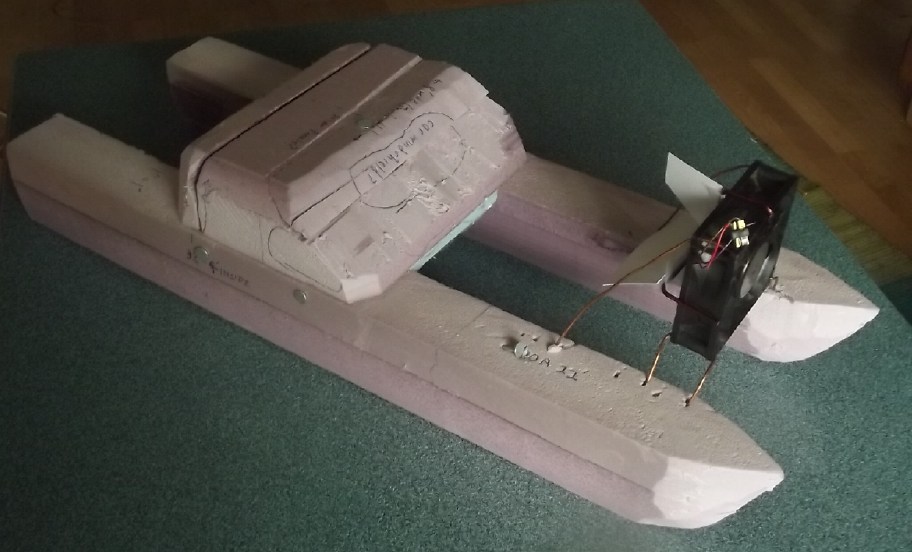 I made a small
model to show the concept of an idea that has been brewing in my mind
for almost a year. The Water-Ski Boat replaces the ground
effect vehicle I have worked on (see many previous issues) with
something I believe to be better, just as fast and more practical.
I made a small
model to show the concept of an idea that has been brewing in my mind
for almost a year. The Water-Ski Boat replaces the ground
effect vehicle I have worked on (see many previous issues) with
something I believe to be better, just as fast and more practical.
Key features are long, narrow, flat bottom "water ski"
hulls and a four way pivoting fan at the front, preferably on gimbals
and controled with a joystick. At speed there's nothing IN the water -
it rides on top with low friction. Expected top speed with just a 10 HP
motor is around 80 MPH.
Aside from the excellent "catamaran" stability, improved
seaworthiness is attained by aiming the fan up and down to lift the bow
and keep the craft level instead of "hobby horsing" through waves like
other boats.
Special Report under Electric
Transport.
Open Loop Air Heat Pumping
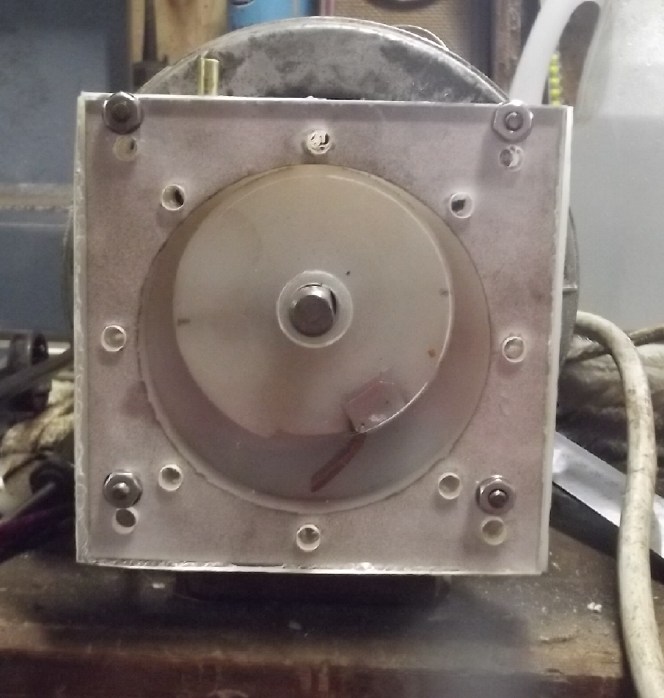 I
worked some on the new compressor and tried it out. The motor turns the
wrong way - UG! There's more to do.
I
worked some on the new compressor and tried it out. The motor turns the
wrong way - UG! There's more to do.
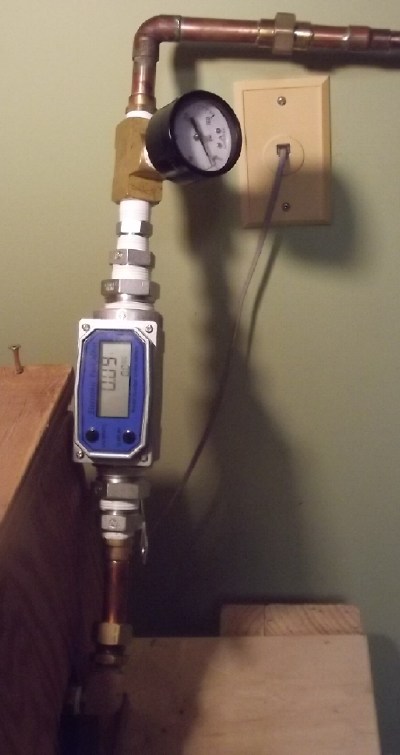 And I got a meter to show the
air flow, but after all the trouble of installing it, the turbine had
magnetic cogging and the airflow wasn't fast enough to overcome it, so
it read zero. I tried a few tricks and may be able to get it to work
with a tiny nozzle to blow air straight onto a vane of the turbine, and
the face of the meter (with the magnetic sensor) backed away by 10mm
from the body.
And I got a meter to show the
air flow, but after all the trouble of installing it, the turbine had
magnetic cogging and the airflow wasn't fast enough to overcome it, so
it read zero. I tried a few tricks and may be able to get it to work
with a tiny nozzle to blow air straight onto a vane of the turbine, and
the face of the meter (with the magnetic sensor) backed away by 10mm
from the body.
Much more in the detailed
report
Gardening
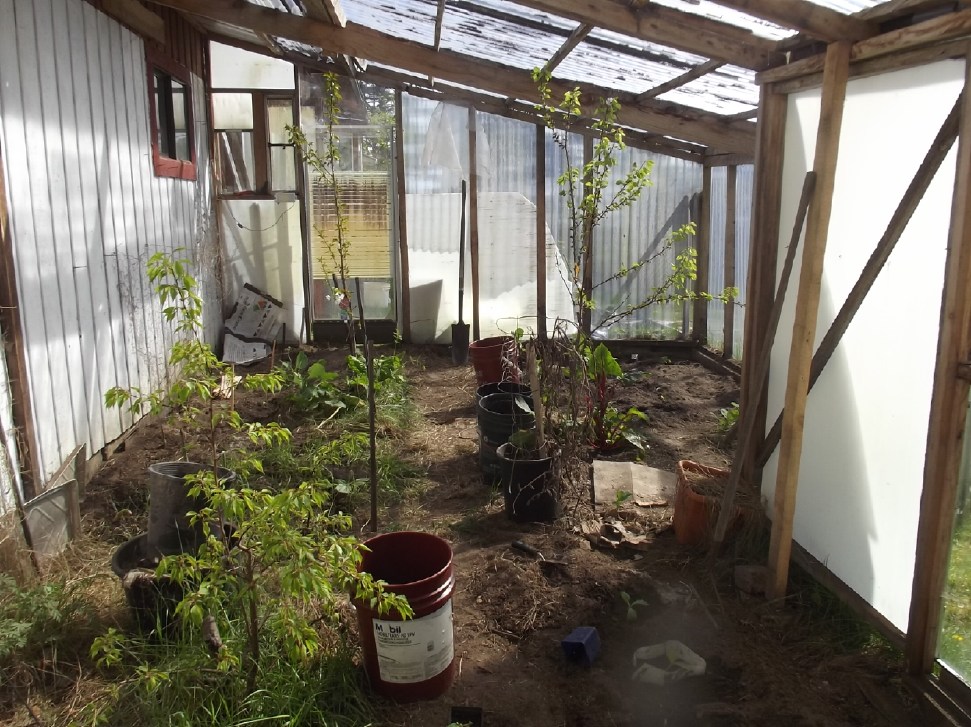 I've put the spring gardening under "other projects".
I've put the spring gardening under "other projects".
I got some window glass from someone
replacing his windows. When I have time I'll replace the greenhouse
plastic walls with glass
Home EMF/Tinnitus Reduction (aren't we tired of this topic yet?)
I've done a lot to try and reduce the EMF field in my
bedroom in the house, but with five plugs, the baseboard heater and
cables going through the floor to the garage and the shop, it seemed
pretty hopeless. I had grounded the metal house roof, put chicken wire
(grounded) over the south wall on the outside, and hung chicken wire
from the ceiling on 2-1/2 sides of my bed. My induced body voltage in
most of the room was still 1.5 to 3 volts AC and even in the bed was
well above the tinnitus threshold, somewhere around .02 V as far as
I've been able to determine.
Since I've been running 36 V DC electric heat for a month
without turning on the 240 V AC baseboard, I finally decided to don
close-up glasses and a flashlight and inspect the tiny 'invisible
pencil' writing on the circuit breaker box [20th]. I found the bedroom
heat and turned it off, then continued looking. Another breaker just
said "bedroom" Contrary to my expectations, all the lights and plugs in
both bedrooms, but no others, were on this breaker. (about 8 plug-ins
and 3 overhead lights) There were plug-ins on the other face of the
bedroom's west wall in the garage, but to my surprise they were on some
other breaker.
With the breakers off the whole room's body EMF went down
to around 1/2 a volt (the wiring to the garage and shop under the
floor), but right by the south wall was lower. If I moved the bed to
there (in front of the baseboard heater!), then with just the grounded
chicken wire mesh under the mattress (or grounded conductive fitted
sheet under the mattress liner) it might be made electricly quiet
enough. I did that and it seemed to just at or under 20 mV lying on the
bed. I added a conductive fitted sheet under the mattress liner, which
lowered it a bit more. Great! Amazing! All I had to do was live without
the baseboard heat, the five plug-ins and the overhead lights. Plugged
into the five outlets I had had my 1976 LED alarm clock, one of the
first ever sold, and a telephone. I can live without those. I have a 6
V LED lamp I made in about 2011 powered by a tube of five NiMH D cells
charged by a ten watt solar panel in the window. I've been using that
for many years now as a bedside lamp. And plugged into the 36V DC
plug-in I have a lamp with a 10W DC bulb - bright enough - and two
heaters totaling round 400 watts, which the last few weeks have shown
should be enough now until next winter. (By then I may be sleeping in
the cabin all winter?) The bedroom AC plugs, lights & baseboard
breakers will stay off until then. (Well, at least at night: the other
'bedroom' is my electronics shop, which I use from time to time. I'll
have to turn it on to use the many tools made for 120V!)
In
Passing
(Miscellaneous topics, editorial comments & opinionated rants)
What Is China's Real
Population?
One expects that an "advanced" country's population can,
should and would be counted to, say, at least two digits of precision
and accuracy. China has been stated to have 1.4 billion people. Lately
I have seen a number of videos (or at least their titles on youtube)
where Chinese are asking "Where has everybody gone?" They show scenes
of empty streets and deserted stores with no customers, and empty
villages and rural areas too, saying things like "In 2019 you used to
have to jostle your way through the crowds. Now there's hardly anybody
here." and "This whole village has only a few older people left. Most
of the houses are empty."
There are more questions than explanations, but it becomes
apparent that more than one factor must be at play. The first is that
censuses are apparently taken by local levels of government and
submitted to the CCP. (Chinese Communist Party) Each town or region has
an incentive to claim as many citizens as it can in order to get more
support from the central government. So figures may be exaggerated by
10 or 20%. Figures for school enrollment are even more exaggerated.
This doesn't explain crowded streets becoming empty, but it does
suggest that "1.4 billion people" was always a substantial exaggeration.
A second factor is the plummeting birthrate. This trend
started - everywhere - with the introduction of the birth control pill.
(Say what you will about educating women and rising standards of
living!) No longer do families appear owing to the sex urge regardless
of desire for them and regardless of economic circumstances. In China
it also started with the recognition of overpopulation and the one
child per couple policy. It was obvious that should and could only be a
temporary measure, and it was carried on too long - largely because of
jurisdictions overstating their populations and the populations of
school age children!
More recently economic circumstances have taken the lead,
as they have in most nations. Those who can barely afford their rent
when both partners work, and who now have reproductive choice, put off
having families to look after and feed, waiting for a better time...
often until it's too late to have one. (In Canada for example, this
trend has been ongoing for 35-40 years now - a couple of generations
with few children.) No longer will there be children unless families
are prospering, and this is becoming a worldwide trend. Today we have
far too many people for the Earth's resources (8 billion... if counting
China as 1.4 billion), so few are prospering and wanting children. But
a lot of this is large aging populations and as us older people die
off, suddenly populations will start rapidly shrinking - some say
"collapsing". In China the one child policy is ended, but people are
having even fewer children now.
Perhaps a third factor is that dissidents in China tend to
disappear, and there has been widespread discontent with Chi Jinping's
autocratic and authoritarian rule. Nobody dares say anything about
anything even to each other (much less point out obvious problems to
the leadership hoping they might be corrected). The widespread and long
lasting covid lockdowns were especially unpopular and seemingly
devastating. I wouldn't be surprised if millions died not from covid
but from the lockdowns. People were actually barricaded in buildings
with no way to get food and sometimes even water, and handcuffed to
railings or posts if they dared come out. How many people in the large
crowds chanting "Chi step down!" disappeared? Whether or not deaths,
arrests and disappearances were widespread, for the same causes it
would seem there have been a lot of Chinese choosing to move to other
countries - another cause of population drop.
But speaking of covid, one of the videos said people have
been "getting a cold", feeling much worse, then going to hospital or
"dying suddenly" in large numbers - perhaps even "huge" numbers.
Especially people in their prime - 30s and 40s. Hospitals are crowded
or overflowing. Statistics for cremations have stopped being published
and burials have become common because the crematoriums can't keep up.
Another video becked this up, saying one had to get in at 5 in the
morning to get a cremation done. Statistics in the first video say that
5% of people in China aged 35 to 44 have died whereas it's only 2.6% of
people 45 to 54. All this corresponds in more extreme form to the spike
in excess deaths in USA since the rushed development and widespread use
of experimental covid vaccines started in 2021, as noted especially in
sad statistics for working age people by life insurance companies, who
keep close watch on such things. (n-acetal-cystene or
n-acetal-L-cystene has been said to be 'antidotal' to adverse and
lasting 'jab' effects. According to one person I know it worked wonders
for him.)
Yet another factor is the weather - droughts but more
especially flooding. Not only were vast areas of crops ruined, but in
diverting the water away from the cities, flat rural areas were
completely flooded. I remember watching a video maybe three years ago
where people were calling for help from rooftops sticking up from vast
"seas", but there was no one to help. How many people literally drowned
in these debacles, repeated in several regions? Were they even
accounted for?
More rational figures seem to suggest the actual
population of China is now somewhere between 800 million and 1.2
billion, depending what you want to believe of all this. Some trying to
estimate using salt sales (apparently a reliable figure) and AI were
coming up with figures toward the upper end, but no one thought above
1.2 billion. A very few people are estimating as low as 300 to 400
million but surely that's much exaggerated. (...OTOH, why are streets
and stores seemingly so empty, according to the videos?) Still it would
seem that there was a large overestimate, probably a serious population
drop since 2019, and the "demographic cliff" of low birth rate which
will cause major further drop over the upcoming decades. but Chi
Jinping and the CCP don't want to admit it. Now they are seriously
trying to give incentives for people to have kids, but it doesn't seem
to be working. Prosperity for the average younger citizen is what the
government should focus on if it wants them to have children. But that
would mean, at least, ending corruption and officials skimming off all
the cream for themselves.
It is possible that China is undergoing a real apocalypse.
Absurd tariffs on exports to USA (China's biggest market) and the wild
uncertainty they cause may tip it into economic collapse. That may
precede a global apocalypse.
Among various things I've just ordered twelve 320 amp-hour
LiFePO4 battery cells (for 36 volts; 11.5 KWH) in anticipation of the
new unipolar motor putting the Sprint on the road with ultra
efficiency. I'm always glad to find China is still shipping goods!
Democracy
in Peril
* After the Ecuadorian presidential election, president Petro of
Columbia preemptively offered asylum to the losers. The election result
was highly suspect, and the "winners" were likely soon to arrest the
"losers" on some pretext to put them out of the way. (I didn't follow
it later to see what actually happened.) This is what also appears to
have happened in Brazil in the last election, where (last I heard)
popular former president Bolsonaro is still in prison. There may have
been foreign interference (USA or US corporate interests) in either or
both cases, but this is not just a "banana republic" Latin American
issue.
Make no mistake: democracy is not only not evolving to
higher forms where concerned citizens are much more involved in
governance, but even such as it is (giving unqualified people too much
centralized power, to make poorly considered decisions on everyone's
behalf), it is under serious threat worldwide. Those oligarchic teams
(often the "leader" being elected is just their figurehead) who have
once attained power to shape things to their own liking along with
their corporate, media and civil service sponsors and cohorts, are no
longer willing to give it up when their term expires just because the
people have decided, or would decide, on a different leader espousing a
different agenda or philosophy in a fair election.
A favorite technique of oligarchies is to control
nominations or the whole political process so that only those they like
can be nominated, or they are the only ones with a serious chance of
winning. One can vote for "Tweedledum" or "Tweedledee" - and get very
similar results. When their more subtle techniques don't work out they
resort to rigging elections, "lawfare" and even murder.
Incidences aren't isolated. Look at the ban from running
and arrests of presidential frontrunners Georgescu in Romania and Le
Pen in France. Next it'll be the leaders of AfD in Germany and Reform
in the UK before they would get the chance to probably form the next
governments? And Wilders, whose party won the last election in an upset
in the Netherlands, was not permitted by the other parties to become
prime minister. (And the previous and "establishment favored leader,
Rutte, who lost, simply resurfaced as head of NATO! Wack a mole!) These
countries are all supposed to be members of the proud and upstanding
"free world".
And of course in Ukraine the five billion dollar
Washington sponsored violent coup d'etat in 2014 saw elected leader
Yanukovitch flee for his life while a government of people previously
selected by Nuland in the US state department was installed. When parts
of Ukraine rebelled against this coup, neo-naziism and military weapons
were pushed in for eight years to regain control over them while US
corporate interests (notably Blackrock) assumed ownership of Ukraine's
assets. (Ukraine was invaded by WHOM, again? ...And with just a "pocket
change" budget and a few snipers!) Since then IIRC Russia has sent
military aid to restore order in at least two other countries where
similar subterfuge seemed to be in progress.
Then there's Pakistan where popular leader Imran Khan's
government lost a surprise vote in parliament. This seemed to be
sufficient pretext to throw Khan out and put him in jail. (I heard that
foreign interference was again involved.)
Evidently Beijing is also behind some international
schemings in smaller countries.
While I'm on it... Going back 45 years or so, Charles
Barber was a brilliant, charismatic and rising young political star
here in BC, Canada. The BC NDP party elite were afraid he would be
elected head of the party over their chosen "party insiders" and become
premier. They found his sexual weakness and set him up, and he had to
flee Canada to avoid going to jail - for decades before the plot was
explained to a judge and the charges were dropped. I don't know if he
ever returned.
So, why is it again that we so rarely ever seem to get any
capable, competent people who are real leaders in governments? They
seem to be kept out or pushed out, time and time again, by any and
every possible means. We badly need to evolve democracy to new forms
and levels of participation, but the leaders we elect under the current
system don't seem to realize the ever more desperate need, or even that
it should be their job to make changes. Whose job is it, then? They say
Rome didn't fail because of what it did. It failed because of the
things it failed to do. It thought everything should continue "as it
has always been done" and failed to evolve as the world changed.
The current trend seems to be toward increasing
disintegration. It may be that national governments everywhere will
fail. If then civilization has to rebuilt from the community level up,
people will be open to and looking for new solutions. Preferably
without a long dark age first. Perhaps my own recent piece about
"Unrepresented Constituencies" might fire up a few imaginations, along
with other new ideas already proposed by creative people?
Scattered
Thots
* Everywhere we see jet trails and long lasting clouds high in the
stratosphere where clouds are [used to be] usually rare and thin. Many
have pointed to a "chem trails" conspiracy, but evidence for
perpetrators is scanty, to say the least. Surely some whistle blower,
somewhere would have "spilled the beans" by now? Then someone familiar
with aviation said they aren't refining jet fuel very purely. So all
the jets everywhere emit lots of fine particles around which water
molecules nucleate and form the long lasting jet trail clouds. These
spread across the sky, whereas in the 1970s - presumably with better
refined fuel - jet trails used to soon disappear and stay gone. The
global amount of jet traffic has become staggering. Much of it is for
cargo rather than for passengers. As explained in previous issues, the
high clouds blanket and warm the atmosphere to way up there, so it
holds far more moisture and disrupts the global wind patterns.
So! All that great stuff that comes from across the world
(esp. China) and arrives at our door in a week or two? ...where shall
we assign blame for all the mayhem? Along with industry, "Ourselves" is
culpable, perhaps all unwittingly.
If there is a conspiracy, it must be in the poor refining
of jet fuel. Perhaps in their ignorance those making it think that
reducing solar radiance with more clouds should cool the earth.
"Experts" have promoted the theory. Probably it's just cheaper to
refine it less purely, and "solar radiance reduction" is a good excuse.
Apparently either jet flights must be stopped or vastly
reduced, or else the fuel needs to be better refined to eliminate
particulate "left-overs". Better refinement will add to the cost of
buying things and passenger travel. The alternative is increasing
droughts, "rivers from the sky" and all the other unusually destructive
weather being seen across the world.
Or, of course, electric aircraft. Ultra light zinc-air
batteries sound like the most promising potential advance in that
realm. Or again, really gigantic ground effect vehicles or giant
versions of the "water ski" boat I propose in this issue, scaled up to
where ocean waves are mere ripples, might move cargo far more quickly
than freighters, without disrupting the atmosphere.
* Speaking of China... Ending a series of recent progressive leaders
like Deng, Chi Jinping quickly proved himself to be an autocratic,
controlling dictator. The whole CCP now bows down to him - or else. It
was inevitable that even in a nation habitually ruled by corrupt
autocrats, people would start to rise up because of bad decisions
affecting their lives, in spite of brutal repressions of dissent. A
dictator or king can be good or bad, but here is the biggest benefit of
democracy: a bad ruler can't stay for the rest of his life, and then
perhaps pass his autocratic control on to his heir. In China people are
now clamoring for democracy because of Chi, and unless Chi willingly
steps down, which seems unlikely, revolution is probably the only way
to change the government.
 * I found this chart of "Increase in Diseases". In at
least a couple (autism, food allergies), children's vaccines are widely
suspected. In many others environmental factors are at play: pollution
and toxic substances in our environment, or the gradual but increasing
degradation of the nutritional value of our foods over the last 75
years. And I do wonder if high AC electric power fields have a role in
any of them, for example, in chronic fatigue?
* I found this chart of "Increase in Diseases". In at
least a couple (autism, food allergies), children's vaccines are widely
suspected. In many others environmental factors are at play: pollution
and toxic substances in our environment, or the gradual but increasing
degradation of the nutritional value of our foods over the last 75
years. And I do wonder if high AC electric power fields have a role in
any of them, for example, in chronic fatigue?
Osteoarthritis is of course linked to boron deficiency and
the doubtless decreasing levels of that mineral in our foods. Taking
3mg boron citrate pills or minute doses of borax is apparently ever
more necessary to prevent or reverse arthritis.
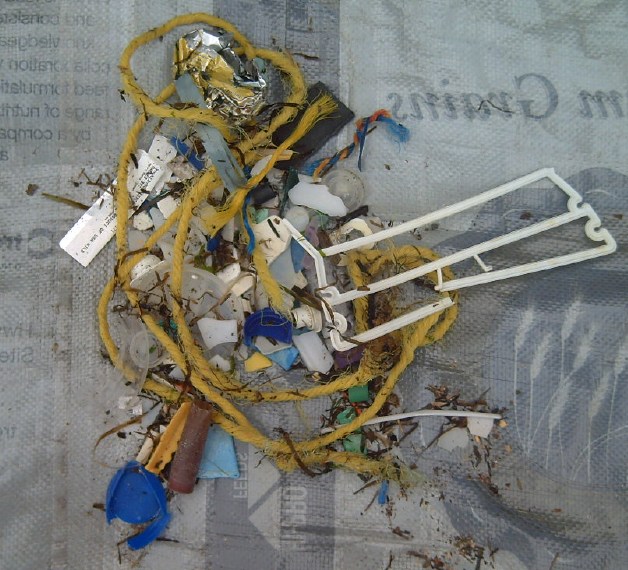 I went for a short walk on the beach. I ended up bending down and
picking up small pieces of plastic almost every step, brought into this
particular area by the waves and tides. The planet, especially the
oceans, is rapidly turning into a sea of plastic bits and many species
of sea birds and sea creatures are being driven toward extinction. We
really need to separate our household garbage and to recycle or burn
all our plastics. Lots of people who do take the trouble separate
theirs into "burnables", "compost" and "garbage". Presently something
like 6%(?) of plastic sent for recycling is actually recycled. It isn't
working.
I went for a short walk on the beach. I ended up bending down and
picking up small pieces of plastic almost every step, brought into this
particular area by the waves and tides. The planet, especially the
oceans, is rapidly turning into a sea of plastic bits and many species
of sea birds and sea creatures are being driven toward extinction. We
really need to separate our household garbage and to recycle or burn
all our plastics. Lots of people who do take the trouble separate
theirs into "burnables", "compost" and "garbage". Presently something
like 6%(?) of plastic sent for recycling is actually recycled. It isn't
working.
A reminder that "single use" plastics polyethylene (LDPE,
HDPE, UHMW - recycling symbols 2,3) and polypropylene (PP, 5) burn
cleanly, eg in a woodstove, or even to light a bonfire or brush pile.
ESD
(Eccentric Silliness Department)
* Can sheep fly? -- It depends on the policies of the airline.
* The green house is for growing plants that need heat. The white house
is for growing mushrooms and emits hot air.
* The house of Parliament (from the French word "parlement", meaning
"pandemonium") is for growing mushrooms on a bureaucratic scale, and is
a powerful source of hot air.
"in depth reports"
for each project are below. I hope they may be useful to anyone who
wants to get into a similar project, to glean ideas for how something
might be done, as well as things that might have been tried, or just
thought of and not tried... and even of how not to do something - why
it didn't work or proved impractical. Sometimes they set out inventive
thoughts almost as they occur - and are the actual organization and
elaboration in writing of those thoughts. They are thus partly a diary
and are not extensively proof-read for literary perfection,
consistency, completeness and elimination of duplications before
publication. I hope they may add to the body of wisdom for other
researchers and developers to help them find more productive paths and
avoid potential pitfalls and dead ends.
Waterski Boat: High Speed, Smooth Riding Water Craft
Design

I haven't worked on the ground effect vehicle model in
quite some time. But since June 2024 a new idea has been brewing in my
mind. The night of June 17th-18th was a sleepless one. Vague ideas
started firming up as I lay awake thinking about it. By the time I was
done I was sure this would be better than the ground effect vehicle for
most if not all potential purposes - simpler, more practical and just
as fast.
So at this point I'm "officially" terminating the ground effect vehicle
project. (not that I've worked on it for quite a long time!)
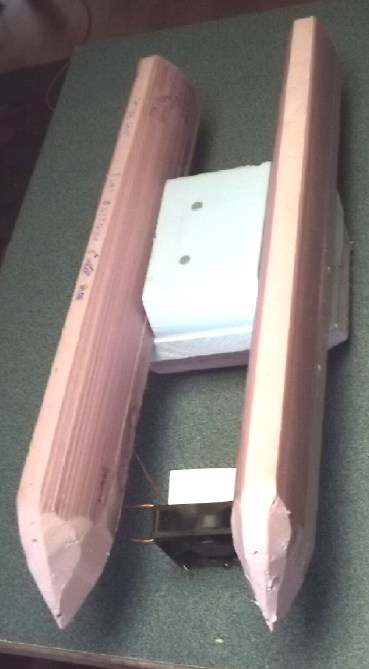 I have long been attracted to the idea of
flat bottom catamarans, ever since I saw one planing under sail in a
sailing magazine picture in the 1980s -- a 12 foot long sailboat said
to be doing 20 knots! That seemed ideal. A sail couldn't have that much
power, yet the boat was skiing over the water.
I have long been attracted to the idea of
flat bottom catamarans, ever since I saw one planing under sail in a
sailing magazine picture in the 1980s -- a 12 foot long sailboat said
to be doing 20 knots! That seemed ideal. A sail couldn't have that much
power, yet the boat was skiing over the water.
Now I started thinking of FAST - maybe as fast as the
ground effect craft? Even faster!?! 100 KmPH? 130? Not with a sailboat!
To make a really high speed craft, longer and much thinner flat
bottoms... like a pair of water skis! To whit, two flat bottom hulls
around 22 feet long and about 6 to 8 inches wide. Instead of flying
just over the water like the ground effect craft, it would slide or
plane across the surface, going too fast to sink in.
But, to give the craft high strength for high speeds, how
about a "tunnel hull" form, a single unit rather than a two-piece
"catamaran"? [Well, the model turned into more of a catamaran.] The
parts in the water while planing can be just the same. I would make it
eight feet wide maximum (so it could be trailered without highway
restrictions) or perhaps a bit less.
My construction material idea for anything like this has
long been "foam sandwich": PP cloth epoxied over extruded styrene
insulation foam - strong and lightweight. (Polypropylene cloth (AKA,
eg, "landscaping fabric") is lighter, stronger and nicer to work with
than fiberglass. Cheaper polyester resin might work fine rather than
epoxy - can probably find out on line.) Someone pointed out that
hitting something sharp with a thin hull makes a hole, whereas with
foam sandwich material, it just makes a dent - no water coming in and
easily filled.
And reinforced with some wood spars and struts where
there's major stress and where people will step on the edges, and
plywood to face the flat bottoms of the "skis" and take impact of
landing on a gravel beach or whatever. The front edges would however
come to a point to cut through wave crests when rough. (Alume and
plastic have been suggested because wood eventually rots, but wood is
strong and can be integrated into the form whereas the others wouldn't
stick to the resin, which doesn't make the actual hull stronger.)
Then we get to the motor and propeller. How does one
prevent cavitation at high speeds? Hmm... hmm... that's a major problem
with fast boat designs. And the propeller leg drags in the water too.
Okay then, how about ditch the outboard and have a fan in the air, like
the ground effect craft? Now we're riding completely ON the water, and
Nothing is IN it.
Now, what about rough water? Can we avoid thin hulls
diving into each wave like most boats, when it aims down after cresting
a big wave? And avoid having the bow rise up and the boat flip over
like those high speed racing boats are prone to doing? My ground effect
craft design had the ducted fans mounted near the front on a canard,
and the canard could pivot up or down. This gave both an airfoil and
thrust aim that could keep the craft more or less level as it passed
over top of the waves and the consequent varying ground-effect lift.
How about making this similar: move the air propeller from the rear to
the very front and have it aimable up and down? Tilting the whole fan
would be better than adding a horizontal vane, and if the cabin (center
of weight) was more toward the rear a canard should be superfluous. The
fan itself could provide the lift to hold the bows out of the water
over dips to keep it level. (Sensors and computerized pitch control
could make it simple to operate? That would be a "deluxe" feature.) In
that sense the front end would "fly" like the ground effect craft and
unlike most boats.
In fact, one could have the fan aimable in all directions
to do the steering, too. Again, no rudder - nothing at all - sticking
down into the water to cause drag. With an electric motor that can
provide reverse thrust this would be far superior for maneuvering when
docking. (A vane would hardly work in reverse.)
[Later reading: A rear fan tends to push the bow down. (or
even the whole boat?) A front fan reverses this, helping to lift and
keep it gliding over the surface as well as lifting the bow over waves.
In addition, a rear fan makes the craft bank outward in a turn making
it unstable, where the front one will pull it in toward the turn.
Having the propeller at the back like most (all?) fanboats actually
makes little sense.]
I had thought of solar panels over the front sections,
perhaps enclosing a forward cabin of sorts. That seemed cool, but now a
fan at the front would get in the way and cast shadows. And doesn't
having a cabin start to lose the "ultralight" concept? Maybe have to go
with "fairly lightweight"? Well, the motor and batteries plus even the
lightest craft construction would probably make it too heavy already.
"Trailerable" rather than something two people can lift and set in the
water. Oh well! (At this point, it could carry a small emergency
outboard at the rear: meaning, it should have a transom to mount an
outboard on, probably at the rear of the cabin.)
This evolved a bit further... Such a boat apparently isn't
for going fishing, it's for transportation. If it was going to go at
freeway speeds, shouldn't it have an entirely closed in cabin like a
car or airplane? Who would want to ride in an open "convertible" in
cold weather or with ocean spray misting all around? And with a larger
enclosed cabin, there should be room for solar panels on the roof.
Maybe even a peaked roof with a panel or two on each side? That would
provide more height for getting across the center section with its high
floor.
Then there's motive power. It seems to me that water drag
would be very minimal at higher speeds. Again it would be On the water,
not In it. But it doesn't need to actually take off like the ground
effect craft. In outboard applications one horsepower of electric
outboard is said to equal four of gas. A ten horsepower (7500 watt)
electric motor might be suitable. (I still have the (10 KW?) Curtis
AC34 or AC35 from the Swift to donate. That should be plenty! It would
surely need a reduction gear to run a something close to a 40 inch
diameter airplane propeller at around 500 RPM, and (how about that!) I
also have a 7 to 1 planetary reduction gearbox to donate. Being 96
volts it would need a lot of 300 AH LiFePO3 cells, but then, it should
run for towards four hours on them. Easily enough to go to the mainland
and back. Wow! That could beat any other sort of transport for rugged
coastlines or disconnected archipelagos except an airplane, with
ultra-low energy use!)
Just to illustrate that the sort of power required isn't
that high: On youtube someone made a small fanboat with a "V" bottom
and counter-rotating propellers having two 3 KW electric motors, total
6 KW. While there was no mention of the actual speed, it moved along
pretty fast. It would have been faster with a flat bottom. ...and still
faster with long, thin "water ski" hulls.
I wasn't planning to have my ground effect vehicle fly
faster than this would go anyway. The design seems superior in almost
every way. The ride on waves doubtless won't be quite as smooth as
actually flying, but it should be much better than most any other boat
of this size range. I would probably never have got farther than a
working RC model of the ground effect vehicle anyway. And I don't plan
to work any more on this by myself either. It's for someone who has a
real, daily use for such a craft to build it.
[2025 02 05] I looked up "Air Boats" or "Fan Boats". These are the ones
one might see in the Everglade swamps with propellers at the rear and
steering vanes behind them. But some are made for speed. I had no idea
how fast they were! Apparently some have been made to travel well over
100 MPH. So my idea of 80 MPH isn't even very remarkable. And they have
generally just got flat bottoms, too. That's great in flat calm water.
"Water skis" should be seaworthy in rougher water, and with the
up-down aimable front fan for attitude control, probably even in quite
rough water. (By which I don't mean 3 meter seas - it is just a small
craft.)
[May 3rd] I searched on line. I couldn't find anything like it. Not
even close. I couldn't even find a flat hulled sailing catamaran like
the one in the 1980's magazine.
This would of course be a major, time consuming project.
But much more sure in construction than the ground effect craft and
much more sure of giving a good result. And I'm pretty sure it would be
safer. For me either one would probably be a toy, unless I actually
dared to go to the mainland and back in it occasionally. But there's
are people living on small islands around here, and more especially,
there's a family living across Masset inlet from everybody else. They
could really, really use such a craft! If a certain friend had the
plan, perhaps he might build it! Various airplane propellers and
hardware are surely available. With the 300+ amp-hour LiFePO4 cells now
available (100V * 300 AH = 30 KWH), at 10 HP (7500 W) it should have
around 4 hours of high-speed running time - even enough to go to the
mainland and back. in one afternoon!
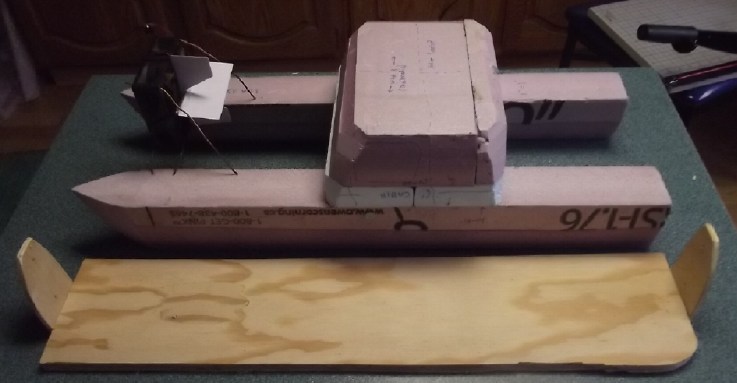 With my thoughts coalescing, I thought about doing a drawing, probably
more of a rough sketch with some figures than a blueprint. [9th]
Instead I made a 1/12th scale foam model, one inch equals one foot. It
isn't intended to work, just to show the concept. I put most of the
effort into shaping the hulls. I made a little jig with the hull
profile in plywood at each end so I wouldn't be cutting freehand, and I
had to make another hot wire foam saw to cut them. For short parts I
used a utility knife. In assembling I simply pinned the pieces together
with 3 inch box nails. I used some solid copper wire to pin on a 3 inch
computer fan as a surrogate for the airboat propeller. (People have
asked "Won't it block the view from the cabin?", but the real one will
just be a regular airplane type propeller, not in a solid box.)
With my thoughts coalescing, I thought about doing a drawing, probably
more of a rough sketch with some figures than a blueprint. [9th]
Instead I made a 1/12th scale foam model, one inch equals one foot. It
isn't intended to work, just to show the concept. I put most of the
effort into shaping the hulls. I made a little jig with the hull
profile in plywood at each end so I wouldn't be cutting freehand, and I
had to make another hot wire foam saw to cut them. For short parts I
used a utility knife. In assembling I simply pinned the pieces together
with 3 inch box nails. I used some solid copper wire to pin on a 3 inch
computer fan as a surrogate for the airboat propeller. (People have
asked "Won't it block the view from the cabin?", but the real one will
just be a regular airplane type propeller, not in a solid box.)
Of course the model is quite fragile.
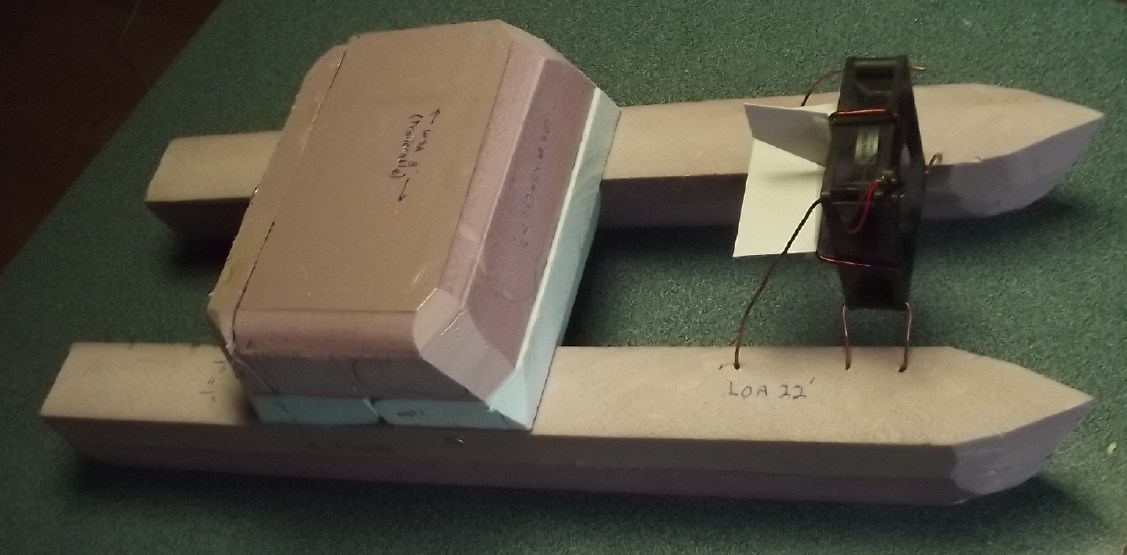
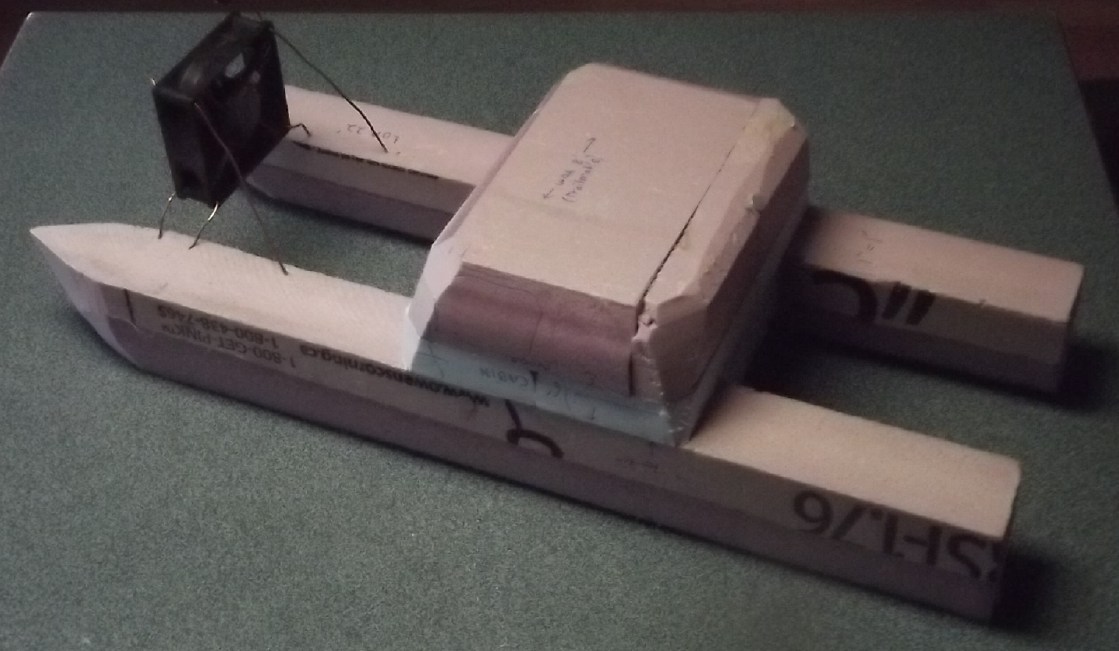
I wrote dimensions and details right on the foam. I shrank
the cabin to 6 feet long, 8 feet wide, more toward the rear for
balance. Presumably the riders are sitting down. That size could hold
eight people, or fewer and some farm produce. (surely eight would be
substantially too heavy!) The hulls, while only 8 inches wide at their
"water ski" flat bottoms, should probably be 2-1/2 to 3 feet tall for
freeboard to handle reasonable waves, and couple of feet wide at the
top. Placing much of the side curve on the inside of the hulls, the
bottoms are farthest apart, and the boat won't tilt much when people
enter and exit from the side. With the cabin sticking up 3 feet,
There's about 4 feet of headroom between hulls (enough for sitting) and
over 5 stepping into each hull, depending how tall the hulls are.
[Advice later was to reduce the height to make it more streamlined so
as not to block the air from the fan.]
The model shows a vertical and a horizontal vane to aim
the air from the fan. Probably a better way to do the vertical would be
to mount the whole fan so it pivots to aim left to right, up to down.
No "canard" as such. Then also there's no vanes having to cross each
other.
Hot Wire Foam Saw With Spring
 [9th] My small hot wire foam cutter wasn't quite 22 inches
long to shape the length of the "22 foot" hulls.
[9th] My small hot wire foam cutter wasn't quite 22 inches
long to shape the length of the "22 foot" hulls.
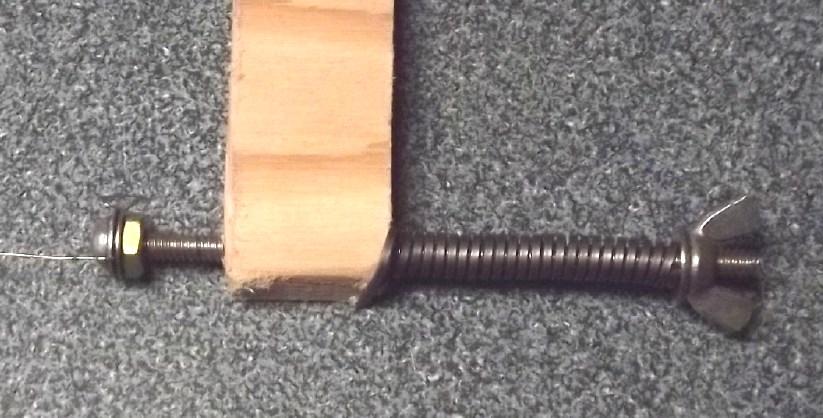 Also, since I was cutting curves and modelling, ideally I
needed one that the wire would stay taut when it got hot. Instead of
making one end a long pivot with a spring on the top side to hold the
wire taut as I've seen on youtube, I simply used a four inch long bolt
instead of a shorter one. I wound a spring from a piece of piano wire
around this bolt, then I pulled it open to make it a push spring. The
wing nut now adjusts the spring tension more than the length. As the
wire heats, the spring pulls the bolt out a bit more. I was surprised
it only moved 1/4 inch or so, but I was keeping the current down to 3
amps (@~15 V) so the wire wasn't super hot. When the power is
disconnected the bolt slowly pulls in again as the wire cools.
Also, since I was cutting curves and modelling, ideally I
needed one that the wire would stay taut when it got hot. Instead of
making one end a long pivot with a spring on the top side to hold the
wire taut as I've seen on youtube, I simply used a four inch long bolt
instead of a shorter one. I wound a spring from a piece of piano wire
around this bolt, then I pulled it open to make it a push spring. The
wing nut now adjusts the spring tension more than the length. As the
wire heats, the spring pulls the bolt out a bit more. I was surprised
it only moved 1/4 inch or so, but I was keeping the current down to 3
amps (@~15 V) so the wire wasn't super hot. When the power is
disconnected the bolt slowly pulls in again as the wire cools.
It didn't seem to entirely prevent the wire from bowing in
the middle, but was much better than nothing. Perhaps a bit stronger
spring? Maybe a brass bushing through the wood? This will probably be
my favorite insulation cutting saw now. (I'm not sure how a round piano
wire became flat when I wound it into a spring.)
Refinements
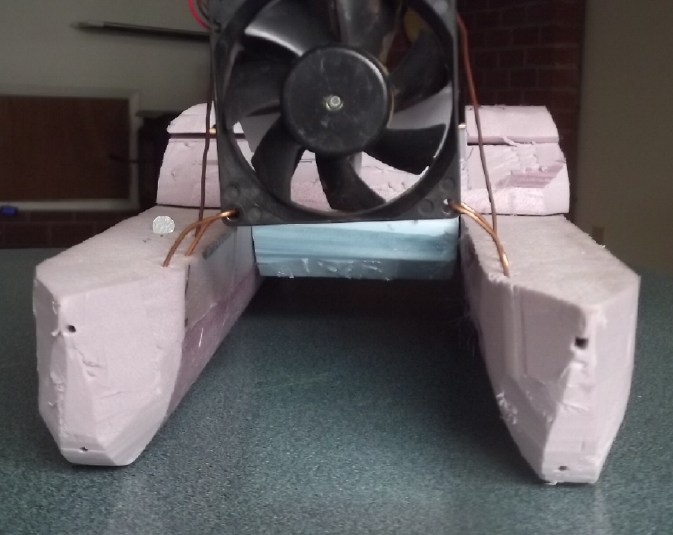 [19th] I showed the model to a couple of boat
people... I mean, to a couple who like boating and have boats. They
pointed out that the bulky cabin was going to block the air flow from
the propeller and showed me a picture of a much more streamlined
catamaran cabin. So I chopped a foot (inch) off the height and made the
front more sloped and aerodynamic looking. The exact dimensions will of
course be up to whoever builds it. Taller would be more comfort, but
one probably won't want to be standing when it is traveling at high
speed anyway.
[19th] I showed the model to a couple of boat
people... I mean, to a couple who like boating and have boats. They
pointed out that the bulky cabin was going to block the air flow from
the propeller and showed me a picture of a much more streamlined
catamaran cabin. So I chopped a foot (inch) off the height and made the
front more sloped and aerodynamic looking. The exact dimensions will of
course be up to whoever builds it. Taller would be more comfort, but
one probably won't want to be standing when it is traveling at high
speed anyway.
The more I think about it, the more I like the idea of
mounting the motor and propeller on gimbals so it can pivot any
direction, rather than having vanes behind it. (Not shown) I suspect
this is more practical with an electric motor than with a fuel engine.
And vanes probably won't work at all when the motor is in reverse, to
maneuver in to a wharf or whatever, whereas pivoting the whole fan will.

I've only been water skiing
once. We had a cabin on a lake when I was growing up and the family
next door had a speedboat. One day the dad was taking kids for water
ski rides. After watching other kids often fall in the water, sometimes
multiple times before they got up skiing, "klutz" Craig tried it and
got up on the first try. We went around for a while until I got bored
and tired of standing balanced with my knees bent. We passed close to
the beach and I let go and skied into shallow water. Once a skier is
planing I don't think they add much drag to the boat.
A pair of water skis is maybe around 5 square feet of
surface area on the water. The boat would be 20 with (two - 6 inch wide
flat bottoms, counting 20 feet long) - only four times as much. But the
skier is planing at maybe 20 MPH. If the boat is going 60, does that
make 4 * (60/20) = 12 times as much "planablility" on the surface? Or
does it go by the square of the velocity, 4 * (60/20^2) = 35
times as much? If the skier is 150 pounds, the boat could plane 1800 or
is it 5250 pounds? I trust the weight of the boat plus passengers and
luggage will be less than even the first figure.
Other
"Green" & Electric Equipment Projects
Open Loop Air Heat Pumping (OLAHP)
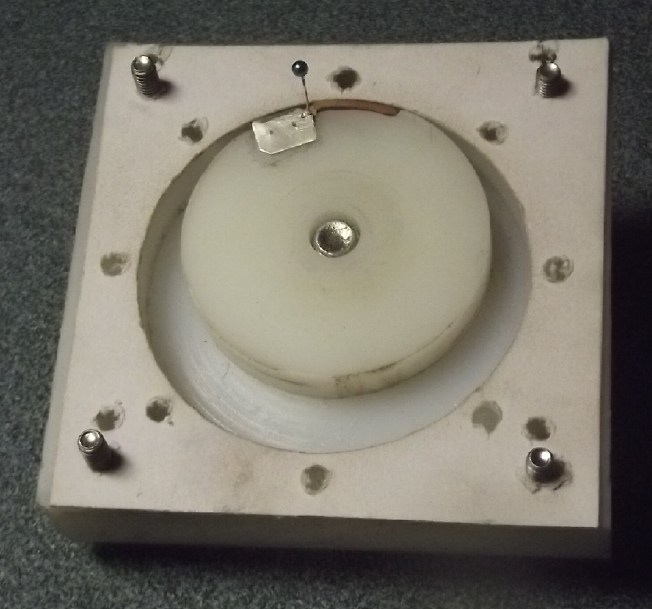 [8th]
I worked on the rotary air compressor, adjusting and getting everything
to fit together well. I turned the outer cylinder a bit farther on the
lathe. The rotor fit in if there was a gasket of one layer of thick
watercolor paper. It would rattle around unless I pressed a bit in the
middle. Then it was pinned. A good fit with minimum air leakage around
the rotating piston when ready to roll will be had by adjusting the
bolts to just the right tightness.
[8th]
I worked on the rotary air compressor, adjusting and getting everything
to fit together well. I turned the outer cylinder a bit farther on the
lathe. The rotor fit in if there was a gasket of one layer of thick
watercolor paper. It would rattle around unless I pressed a bit in the
middle. Then it was pinned. A good fit with minimum air leakage around
the rotating piston when ready to roll will be had by adjusting the
bolts to just the right tightness.
I think I'll put the air intake and exit through the
transparent lid. That way if they prove to be in non-optimal positions
I only need to replace the lid which just needs a few CNC
drilled/routed holes, not the cylinder which also needs to be turned to
perfect size and smoothness on the lathe.
Remaining:
- air intake hole
- air outlet hole with one-way flap and pipe fitting exit
- pivot pin for swiveling vane/flap
- threaded hole & set screw to attach rotor securely to motor shaft
[14th] I started with adjust the mounting of the pivoting vane. It was
tedious, exacting work and I kept using a magnifying glass and a close
light. I milled depressions in the rotor to hold a "U" shaped piece of
alume and gradually worked down the dimensions of that piece with a
file and tinsnips. With even the smallest bolts the heads stuck out. I
had no flat head bolts in tiny sizes. I ended up drilling tiny holes
and sticking pins in. But the holes with my tiniest drill were bigger
than the pins. Hold to hold them in place? I finally hit on bending the
pins so they had friction in the holes.
Then I tried drilling holes for a pin for the flap/vane.
The piece seemed too fine to center punch, but the drill wandered. I
think I had three tiny holes in each side before a couple of them lined
up well in a good place. It didn't seem like much but I spent hours on
it and it wasn't finished. I did get it so the assembly would spin past
the narrow point of the rotation - at least with the top cover off. A
few adjustments to go.
 [16th]
The flow meter arrived. It had a little four blade turbine inside. I
didn't pay any attention to how it worked. [19th] I bought some
adapters for it to go from its 1 inch pipe threads to the 1/2 inch
pipes I was using. When I got home I discovered I didn't have a
'nipple' fitting and I couldn't find my teflon thread sealing tape.
[22nd] I bought a nipple and some more tape. Then I put the flow meter
together and into the line. It was so heavy I screwed an angle bracket
to the compressor box to support it. I wanted to try it out first with
the original fridge compressor before (finishing and) installing the
new pivoting vane compressor to see how much difference there would be.
[16th]
The flow meter arrived. It had a little four blade turbine inside. I
didn't pay any attention to how it worked. [19th] I bought some
adapters for it to go from its 1 inch pipe threads to the 1/2 inch
pipes I was using. When I got home I discovered I didn't have a
'nipple' fitting and I couldn't find my teflon thread sealing tape.
[22nd] I bought a nipple and some more tape. Then I put the flow meter
together and into the line. It was so heavy I screwed an angle bracket
to the compressor box to support it. I wanted to try it out first with
the original fridge compressor before (finishing and) installing the
new pivoting vane compressor to see how much difference there would be.
Unfortunately the air wasn't moving fast enough to make
the turbine go, so it just read zero. even with 40 PSI pressure
(thicker air). I disconnected the pipe union at the top. Operating
against no pressure didn't do it either. The only way I could get it to
spin was to put my finger over the open end of the pipe until it built
up some pressure, then suddenly remove it so the extra air came out in
a whoosh. Then it would advance a few units and stop again. (For liquid
those units are supposed to be litres, but thin air was never going to
push the turbine as strongly.) I was afraid of that, especially since I
had noticed it didn't move unless I blew into it fairly hard before
installing it. Once spinning it continued easily for a couple of
seconds and the numbers advanced, but it was hard to start it. I
wondered if it was sticking magneticly.
It just might show if the new compressor made it work
where the fridge compressor didn't. But even if the air was twice as
fast, I wasn't at all not sure it would start moving.
[23rd] I took the front off it. It had a circuit board with two AA
cells, but there was no opening from there into the pipe. There seemed
to be a magnetic pickup facing the metal pipe. So to get at the
turbine, I'd have to dismount the unit and see if there was some way in
from one end. [24th] I unscrewed the pipe unions and took it off. This
time I looked when I blew into it. Sure enough, it didn't move until a
certain amount of force, then it spun freely. Then it would suddenly
stop and go back and forth a bit until one of the fins pointed at the
sensor. Magnetic cogging! Once spinning the cogging cancels out so it
would probably have been pretty accurate, but it wouldn't start. I
decided there was probably no way to make it work with any compressor
I'll use. I put it back on anyway. We'll see.
[27th] A new idea occurred to me. 40 PSI + atmospheric pressure = 55
PSI. If I measured after the decompression with the air at atmospheric
pressure, the flow rate should be 55/15 = 3-2/3 times faster. It might
get it to spin. It seemed worth trying.
The decompressed air output to the outdoors was a thin
tube. If I put a brass tube in the end of that as a nozzle, and stuck
it right into the unit by a the fan blades, it still wouldn't spin. But
if I then blew into it it would start and keep spinning. I took a
measurement: 13.5 litres/minute. Probably nothing like a real value,
but if I measured the same way with then new compressor, I would get a
relative measurement. I took a couple more readings, sticking the
nozzle in slightly different places, to see how consistent it was.
18.5, 8.6. Obviously not good enough even for a relative indication. I
would have to set it up so the nozzle was in the exact same position
each time.
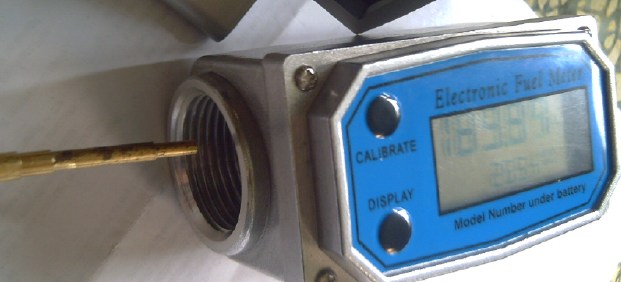 I tried smaller nozzles. When I got down small enough, the unit would
start spinning! I didn't even have to insert it very far or aim it
much. But I soon found out that it only worked if the ends of the meter
were wide open. Apparently the fast moving air drew in more air from
around itself and so more air was actually flowing through the meter.
It didn't work once the outside was closed off. If the ends weren't
closed off the cold air would be going into the house instead of to the
outside. There was still one way it might work: if the meter was
outfitted with the nozzle and was attached outside the house to the end
of the air exhaust hose when readings were to be taken. Awkward,
inconvenient - but still a way to reliably get readings of the relative
difference in air flows with different compressors.
I tried smaller nozzles. When I got down small enough, the unit would
start spinning! I didn't even have to insert it very far or aim it
much. But I soon found out that it only worked if the ends of the meter
were wide open. Apparently the fast moving air drew in more air from
around itself and so more air was actually flowing through the meter.
It didn't work once the outside was closed off. If the ends weren't
closed off the cold air would be going into the house instead of to the
outside. There was still one way it might work: if the meter was
outfitted with the nozzle and was attached outside the house to the end
of the air exhaust hose when readings were to be taken. Awkward,
inconvenient - but still a way to reliably get readings of the relative
difference in air flows with different compressors.
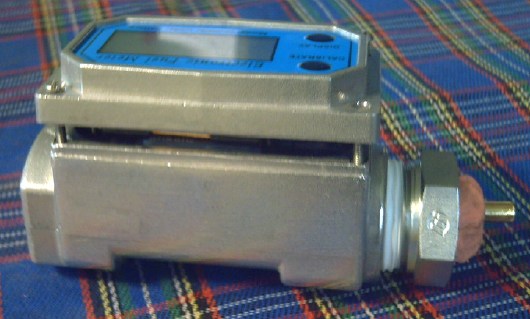 Still trying things out... I found the meter would count even if the
sensor was backed away from the pipe/turbine by ~10mm. This much
reduced the cogging. The exhaust air through the small nozzle would now
start it turning even with the end otherwise sealed. Hurrah! I put in a
plastic piece for a spacer and longer screws to hold the front attached
but away from the body.
Still trying things out... I found the meter would count even if the
sensor was backed away from the pipe/turbine by ~10mm. This much
reduced the cogging. The exhaust air through the small nozzle would now
start it turning even with the end otherwise sealed. Hurrah! I put in a
plastic piece for a spacer and longer screws to hold the front attached
but away from the body.
In the process I had been running the system for a couple
of hours. It was 12° outside and 22.2° in when I turned it off and
turned on the 400 watt plug-in heater. After quite a while it was still
22.2°. The fridge came on and it rose to 22.6°, then dropped back to
22.2° after it went off. I put the heat pump back on and got almost
identical readings. I saw a 22.7° and 22.8° when the fridge was
running, but after it went to 22.2° again. Then I turned it off and in
10 or 15 minutes it had dropped to 22.0°. Then the fridge came on again
(danged fridge!)
The heat pump was 100W (compressor) and 5W (compressor box
fan). (I left the main radiator fan off. It only helps a bit.) That's
105 watts to do what a 400 watt radiant heater did. So it seemed to be
a COP pretty close to 4. It wasn't very cold out, so that's no better
than a refrigerant based unit. The planned improvements, even derating
them for the performance I'm likely to get, should make a tremendous
difference:
COP now = 4
More efficient compressor: + 1.5
Decompressor: + 2
Hmm, that's only COP = 7.5. No doubt my indoor-outdoor heat exchanger
can be improved on too. It may take some more advanced engineering than
I'm doing so far to get it up to COP = 10 at 0° outside. The kind of
perfecting done when one is planning to mass produce and sell zillions
of them.
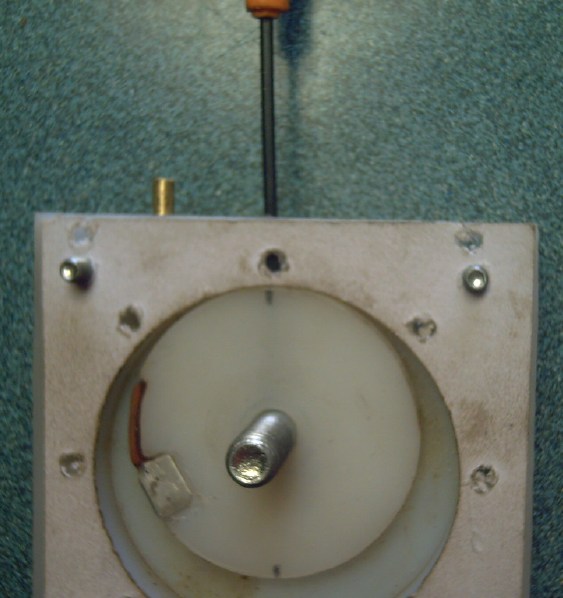 [29th] I drilled a hole in from
the edge of the piston, threaded it, and put in a set screw. When I
tightened it it made it bulge ever so slightly to that side and
wouldn't pass the narrow point. So I did another one on the opposite
side. If each set screw was tightened equally and not too much, it
worked.
[29th] I drilled a hole in from
the edge of the piston, threaded it, and put in a set screw. When I
tightened it it made it bulge ever so slightly to that side and
wouldn't pass the narrow point. So I did another one on the opposite
side. If each set screw was tightened equally and not too much, it
worked.
Small Ball Bearing in
two-step air output
hole
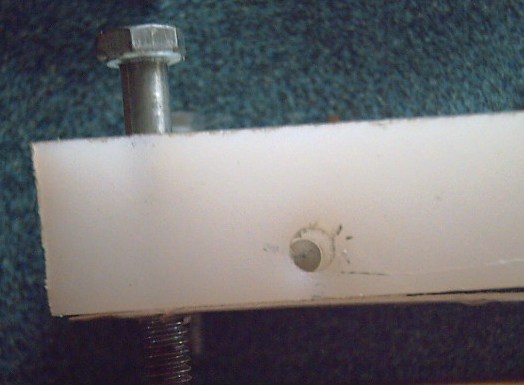 [30th] I somewhat reluctantly
drilled the air holes in the compressor cylinder. It was a matter of
judgement where to put them, but a couple of the case screw holes were
in the way where I would have most preferred to put them. So I went a
little over to the narrower sides, which was probably better anyway.
The intake is just a through hole, but the outlet needs to have a one
way valve so that the compressed air doesn't blow back in after each
compression cycle. The most practical way I could think of to do this
was to drill a small hole from the outer edge right through to the
cylinder space, then a larger hole but not quite all the way in. Face
the hole Up and drop in a ball bearing that only fit into the larger
hole. When the air was compressed to a higher pressure than the output,
the ball would be pushed up and the air would flow out. When it was
lower, the ball would fall back and block the smaller hole. This seemed
to work pretty well.
[30th] I somewhat reluctantly
drilled the air holes in the compressor cylinder. It was a matter of
judgement where to put them, but a couple of the case screw holes were
in the way where I would have most preferred to put them. So I went a
little over to the narrower sides, which was probably better anyway.
The intake is just a through hole, but the outlet needs to have a one
way valve so that the compressed air doesn't blow back in after each
compression cycle. The most practical way I could think of to do this
was to drill a small hole from the outer edge right through to the
cylinder space, then a larger hole but not quite all the way in. Face
the hole Up and drop in a ball bearing that only fit into the larger
hole. When the air was compressed to a higher pressure than the output,
the ball would be pushed up and the air would flow out. When it was
lower, the ball would fall back and block the smaller hole. This seemed
to work pretty well.
 Then I found a small brass tube and expanded it to a good friction fit
a bit by pounding it with a drill bit inside. I crimped the inner end a
bit so the ball bearing couldn't fit into the tube or block the air.
Next I need to expand the tube to adapt it to regular pipe fittings.
Then I found a small brass tube and expanded it to a good friction fit
a bit by pounding it with a drill bit inside. I crimped the inner end a
bit so the ball bearing couldn't fit into the tube or block the air.
Next I need to expand the tube to adapt it to regular pipe fittings.
Then I realized that with the cylinder mounted on the
motor, when the piston was pushed onto the motor shaft and inside the
cylinder, there was no way to get at the set screws to tighten it on. I
had to drill a hole through the cylinder to insert the hex wrench
through. I drilled it through at the narrowest point, then realized
that was a mistake. That's right where the piston and cylinder are
supposed to touch and seal the compressing air. Hopefully it'll be all
right, but it certainly won't improve it! I should have drilled it just
past that spot. I suppose if necessary I can melt a bit of plastic in
and trim it with a knife, then drill a new hole, rather than make a
whole new cylinder.
The pins holding the vane and it mounting on stuck out a
bit. They were gouging the cylinder. It seemed my grinders would be too
coarse to deal with them, and they seemed hard enough to dull a file. I
finally thought of the 'dremmel' tool with a tiny grinding wheel. That
did the trick.
[May 1] Everything was now ready except I wanted the mountings on the
motor to be stiffer than just #10 threaded rods. I cut four pieces of
1/8 inch brass pipe to slip over the bolts. Except for not having the
pipe to connect the output, it seemed ready to assemble and try running
it. Even if the output was open it should blow air.
I took a couple of pictures before trying it in case it
fell apart or something.

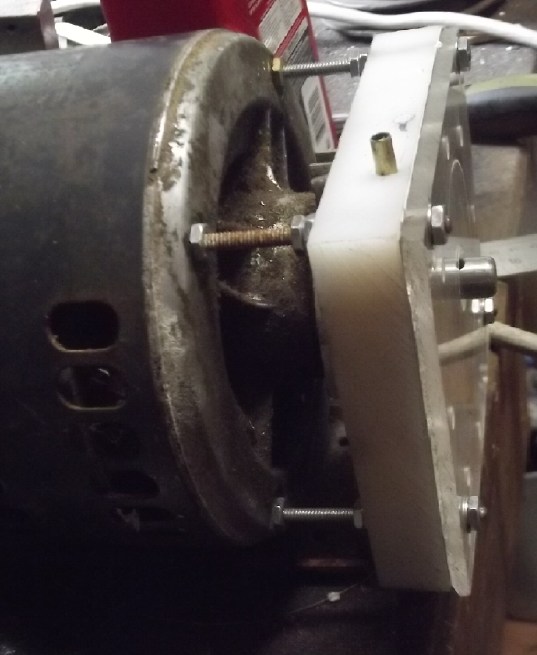
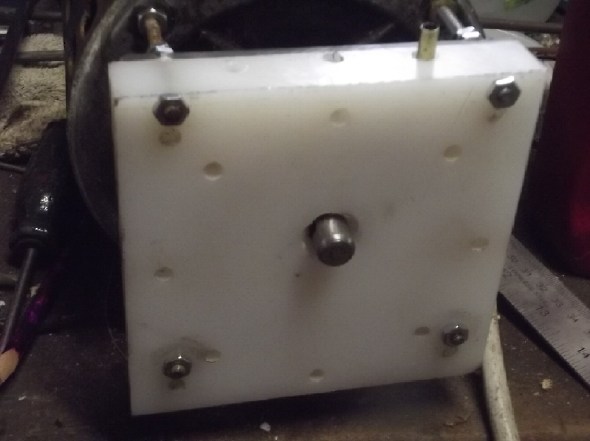 When I turned it on
I discovered the motor turned counterclockwise instead of clockwise!
(I'd swear I had already checked and it was right, but there it was. I
seem to be easily confused by mirror images.) At any point up to
drilling the air holes I could have simply drilled them opposite,
turned the rotor around and run it the other way. Now I had to turn the
whole cylinder around with the transparent cover facing the motor. Yuk!
When I turned it on
I discovered the motor turned counterclockwise instead of clockwise!
(I'd swear I had already checked and it was right, but there it was. I
seem to be easily confused by mirror images.) At any point up to
drilling the air holes I could have simply drilled them opposite,
turned the rotor around and run it the other way. Now I had to turn the
whole cylinder around with the transparent cover facing the motor. Yuk!
I had loosened off the bolts holding it together because
it was too hard to turn. Now it needed another layer of gasket. It
turned but it stopped really fast when unplugged, and I couldn't feel
any air trying to push out of the air outlet. It smelled like hot
plastic. Well, next time! I seem to get discouraged easily these days,
and I'm spending a lot of time gardening. To tell the truth while the
theory for this compressor seems super, I don't have much confidence in
my construction. Hopefully I'll get it working, because OLAHP seems too
good to abandon. (OTOH, once again I seem to have set my
ultra-efficient axial flux, unipolar car motor aside until...???)
Gardening
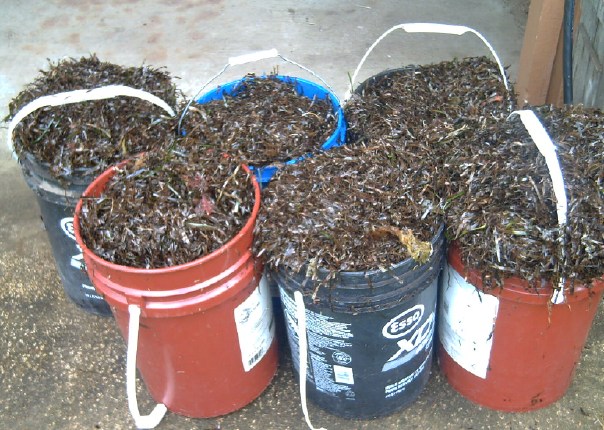
Eel Grass from the beach for Mulch &
Fertilizer with lots of trace minerals
There are lots of videos on
line and books about gardening, but one must be aware of where the
garden is growing. There's no point listening to someone enthuse about
how easy it is to grow oranges if you're too far north to grow them.
Most of them apply to more typical climates, for example inland North
America with hot summers and cold winters. So I keep this log in hopes
that those growing on the moderate BC/PNW coast and especially Haida
Gwaii, where summers don't have the heat but winters are fairly mild,
may find some good tips. (Gardening on Vancouver Island and in England
seem to be closest, but not quite the same.)
I finally got serious about seaweed/eel grass and
took my car down near a beach where some had piled up, with six
buckets. I stuffed them full and carried them up the beach to the car.
I had enough to do a lot of mulching to keep the quack grass at bay
around my berry bushes and trees. That was much better than collecting
a lightly packed bucket here and there when I went for a walk because
it's substantially farther to carry them. I might have had 2 or 3 by
now. Instead I'll go down for another 6 soon if the tide hasn't carried
it off.
Fruit Trees
In March I tried doing six grafts to two apple (3,1) and
two pear (1,1) trees, hoping for better pollination and better fruit
varieties. My brother in Toronto is a grafting whizz but I've never
made a successful graft in my life. He said you have to put the tape on
really tight or the sap pushes the graft away from the base. That's
probably my big mistake - I always taped them fairly loose so as not to
restrict sap flow. Only after a couple of months(?) the tape should be
unwrapped, for that reason. I did all "cleft" grafts - I think that's
the name - a "===<" and a "<===" (longer and thinner than that)
that fit together. If they're not identical in diameter, match up the
sapwood (where the sap flows!) on One side of the graft rather than
trying to center them. It looks like some of them are taking! (May 5th:
ONE of the grafts, on a pear tree, has ONE leaf coming out. I must have
broken the other two buds off somewhere in the process. Well, if it
lives my lifetime grafting success rate is no longer a big fat zero!
And maybe some year soon it'll grow some flowers to cross pollinate the
rest.)
I bought two "Scout" apricot trees in about 2018. They're
a bit of a sad story. They kept getting dried out over the winter, when
I didn't think they'd need watering - I really didn't think about
gardening in winter. Instead of growing, they shrank. One finally died
completely and the other the trunk died and it was reduced to a few
shoots near the bottom. I cut some shoots off to have one long one near
the center grow into a new trunk, and replanted it from the house
garden to the greenhouse. (I have finally learned to water trees and
blueberries every few days all fall, winter and spring as well as in
summer - especially being sure to do those in the greenhouse where it
doesn't rain.) But the whole time, even when they were healthy, and
notwithstanding a swarm of hoverflies around the profuse flowers at
least one year, I never got a single apricot.
I was told apricots are self pollinating. On line it said
apricots are self pollinating. Last year there was another apricot
tree, "Moorpark", at the garden store - the first one I've seen since I
got mine. I bought it and planted it also in the greenhouse. This
spring they both bloomed and lo and behold, Both trees have set fruit!
The new one looks really loaded; the poor old Scout "shrub" just had a
couple, that fell off. Maybe next year? I looked on line again and
found a site that said MOST apricots are self fertile "except a few
varieties, such as Scout." Thanks, to all those web sites that didn't
bother to mention that! (Where's "Politico" with their "fact checking"
for "misinformation" when you need them?)
I ordered, and this year I finally got [16th] a "yamhill"
hazelnut tree and a very small strawberry tree/bush (Arbutus Unido). My
last strawberry tree was another sad story. I kept it in its pot for
years, not being sure where to plant it. I finally planted it in the
main garden and it died. I think for once I watered something too
much(!) and the roots rotted. Or perhaps I put in too much fertilizer
and burned the roots. Or something. Anyway, I'll try again. It's small
but if I don't kill it too, it'll grow. One more tree to go... the
garden place couldn't get the nectarine/peach I was after. "Frost"
peach was substituted, and it didn't come last year either. It's
supposed to be coming - maybe today [May 5th].
The yamhill is going to go in the main garden near the PNW
native beaked hazelnut. (Hazelnuts need cross pollination.) On impluse
I also bought a plum tree, while they were there. I'm not sure where
I'll put it.
I planted the black walnut sapling that my brother brought
from Ontario last year in March. I was afraid it would be totally
shaded by the carport in the one place that seemed suitable to plant
it, until it got much taller. But as the sun comes north in mid April
it's already getting sun except right at the base, so it should be good
for the summer. And next year, if not by September, it should be
taller. But I sure wish I hadn't broken the top bud off last year. It's
growing four almost equal outward branches instead of a straight stem,
while the top has died back. I wonder if I should prune off three of
them? But removing three out of four branches seems like too much of a
tiny tree to remove. The carpathian english walnut seems to be growing
nicely. Someday (hopefully) there'll be cross pollinating walnuts here!
I started watching a video about six tips for getting
prolific blueberries from your bushes. I didn't got past #1, "get the
weeds away because blueberries have shallow roots and the weed roots
compete with them." I've been transplanting the ones from the lower
("main") garden up to the one by the south wall of the house because I
can never keep the grass away from them down there. By the house
there's a chance. I've managed to scrape away a lot of grass and weed
roots from around them. (Mulch, mulch!) The tab for the video is still
open in my browser in case I get to #2. At least I've learned to keep
them watered over the winter so they don't die. We get a lot of rain,
but the dry periods catch me unawares.
In the House
Orange mini-bell pepper.
(A few, tiny, mostly still green)
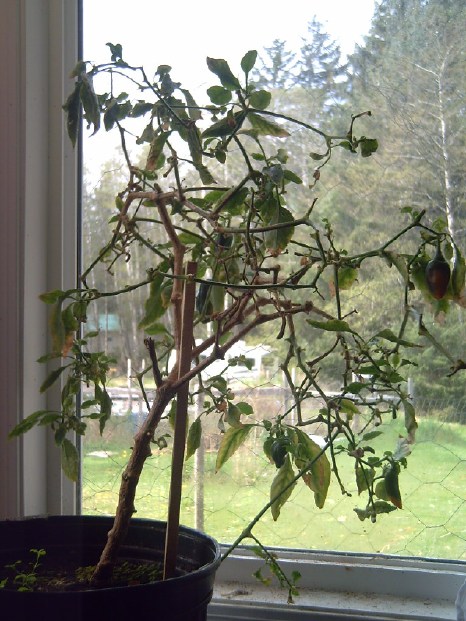 My almost 3 year
old pepper plants look pretty bare. One died, making a last banana
pepper instead of new leaves. The other one and the orange mini bell
are still growing fruit too. I repotted it in a bigger pot. I think
they would like it warmer than I can make the window sill most of the
year. We haven't been getting much sun.
My almost 3 year
old pepper plants look pretty bare. One died, making a last banana
pepper instead of new leaves. The other one and the orange mini bell
are still growing fruit too. I repotted it in a bigger pot. I think
they would like it warmer than I can make the window sill most of the
year. We haven't been getting much sun.
Avocado, with banana pepper behind.
A coffee tree far left.
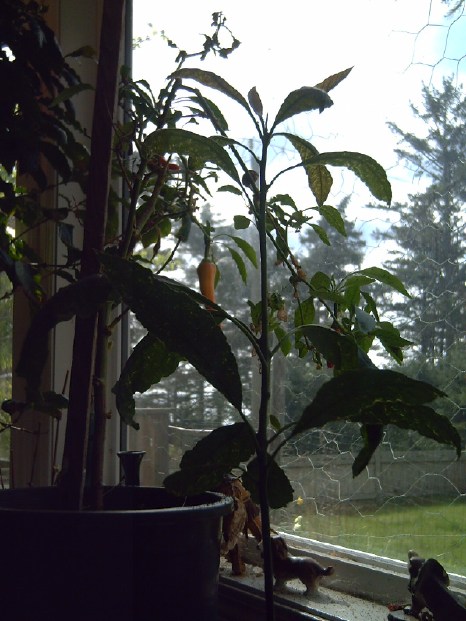 The avocado (why did I plant that?) has grown
a couple more levels of leaves.
The avocado (why did I plant that?) has grown
a couple more levels of leaves.
It and the peppers are very aphid infested and I hope it's
warm enough to put them out in the greenhouse for the summer soon,
where other bugs will eat the aphids.
Coffee 'beans' have been ripening for a couple of months.
I think I have enough to roast and make a couple of pots of coffee now.
But the new beans aren't huge like the first round. They seem like
"normal" size beans. From the same three trees that made the giant
ones. Odd. Of course I have had the coffee plants in the house under
LED lights all winter. They'd probably die over winter without the
lights. and watering.
Greenhouse(s)
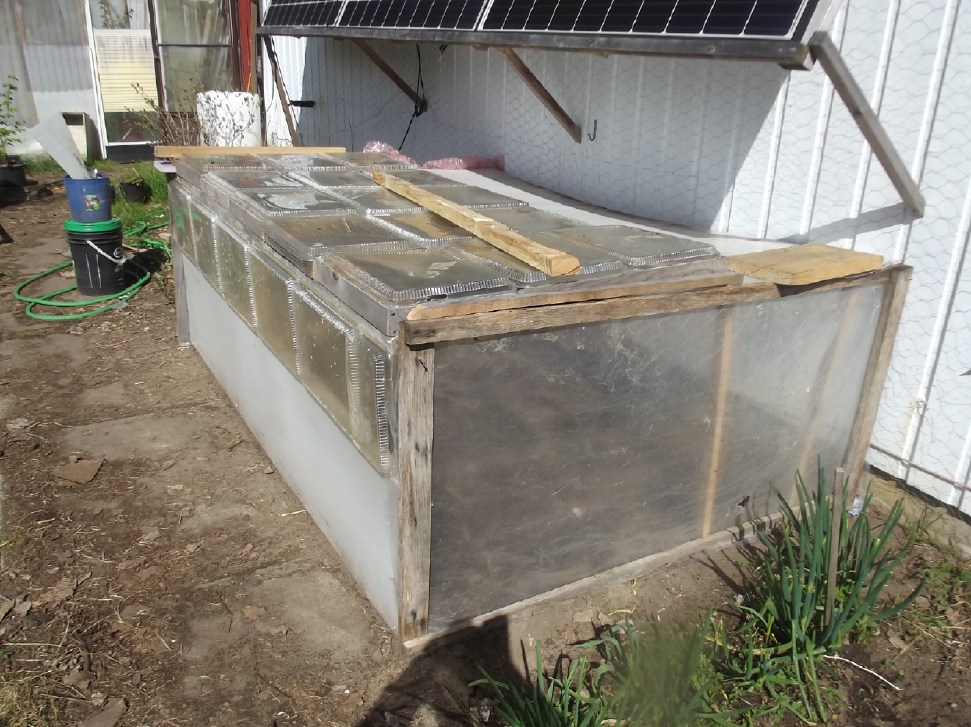 Well, I got some corn, and then a few other seedlings started... at
almost the end of March. By early April the corn needed to get planted.
I reassembled the box "greenhouse" I made last year and put them in.
Last year, to my surprise the corn in the middle and toward the back
did much better than that near the front and outer walls, some of which
died outright early on. This time I took pains to fill in the large
gaps between the pieces of the box, where cold air could blow in. And I
planted more at the back, notwithstanding that there's less light there.
Well, I got some corn, and then a few other seedlings started... at
almost the end of March. By early April the corn needed to get planted.
I reassembled the box "greenhouse" I made last year and put them in.
Last year, to my surprise the corn in the middle and toward the back
did much better than that near the front and outer walls, some of which
died outright early on. This time I took pains to fill in the large
gaps between the pieces of the box, where cold air could blow in. And I
planted more at the back, notwithstanding that there's less light there.
The corn at the front and sides seems to be growing
better, more even with the inner ones.
I took the electric rototiller and the weed and rock
sifter and started reclaiming my greenhouse from the grass, which had
been taking over more and more for 2 or 3 or 4 years. There was still a
little corn and I planted three short rows. Corn has never really
worked in the greenhouse before, but I thought I'd try again. But I
don't think it gets enough light through the plastic roof & walls.
Somebody replaced the windows in their house and gave me the old ones.
(Rats, now that I've already done the cabin windows!) If I find time
I'll replace the greenhouse plastic walls with glass. (I'm not so sure
about the roof, but there's quite a lot of glass!)
Then I planted a couple of pumpkins and some cucumbers. I
need to look up growing cucumbers - IIRC they need some sort of trellis
to climb on. I dragged "the claw" over my small greenhouse asparagus
patch in March to pull out some grass and plucked a couple of shoots in
mid April. But I try to pluck one from where two shoots are sprouting
so as to not kill them entirely.
 Looking toward East side of greenhouse
Looking toward East side of greenhouse
"Leftovers" corn patch far R corner area.
Old abused "Scout" apricot "bush" (Fr L) seemed to have set a bit of
fruit for the first time, but then it fell off.
Cherry tree (mid L, also purchased last spring) has some flowers.
The buckets are for weeds, fertilizer, compost dirt...
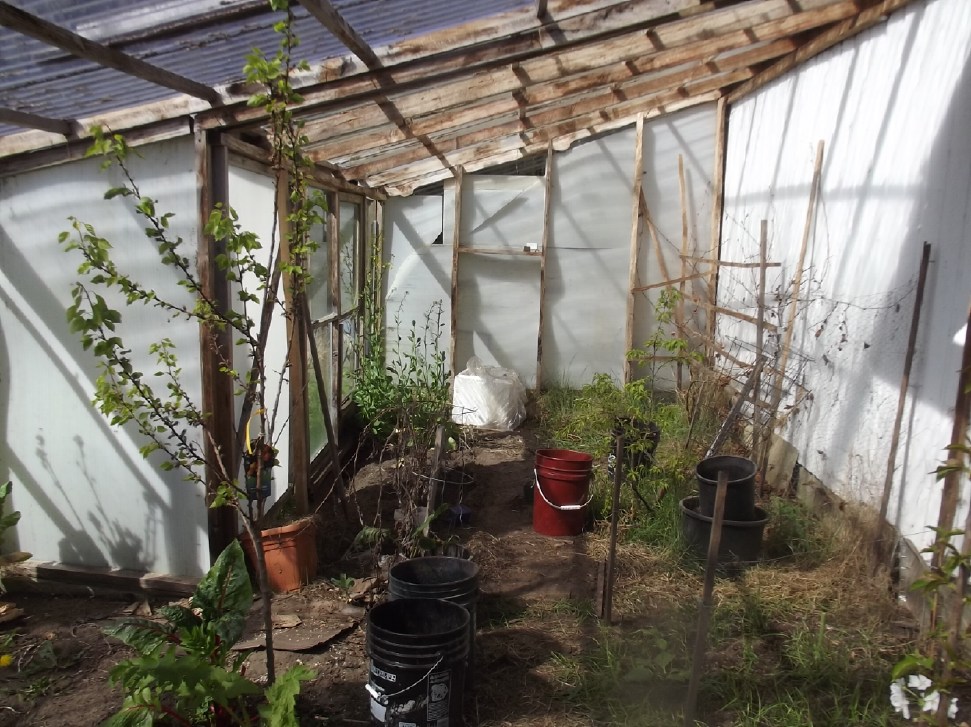 Looking toward West side.
Looking toward West side.
Asparagus (6 years[?] now) is in front of empty pots, R.
Moorpark Apricot (L. fore) is loaded with tiny apricots
Grape vine far R. (More crab grass to deal with there)
Some cabbage/broccoli going to seed and some chard, far L. and here and
there.
The grapevine is growing
well, spreading out. It had one small cluster of grapes the first year
but none the next (last year). I'm sure I should be trimming it more
according to advice on line, but not sure where to cut. Hopefully it
will have more of a crop this year. It said it was a green grape vine,
but they turned purple anyway.
The potted tomatos in the house, which I complained didn't
grow any tomatos all winter, started flowering just as I started
tossing them out in disgust. Only a couple actually got left out in the
cold. Now there are green tomatos - cherry and roma. Well, none all
winter but who gets tomatos in May and June around here?
Toward the end of the month a yamhill hazelnut tree and a
strawberry tree (or strawberry bush - Arbutus Unido) arrived at the
plant store. I've been waiting way over a year - they couldn't get them
last year. The Unido tag said "ornamental fruit" - hmpf! They are
delicious! It's a very small bush at this point. I think this time I'll
plant it in the greenhouse, since the other (and much larger) one died
when I planted it in the main garden (Ouch!). This island is pretty far
north. The greenhouse seems to be turning into a "warmer climate" fruit
tree habitat. Also the birds won't be eating the fruits.
The yamhill I'll plant in the main garden near the beaked
hazelnut, which will be its pollinator.
On a whim I bought a couple of packages of tree seeds:
birch and black locust. At the end of January I put some in the fridge
in moist potting soil. It said to keep them cold for 3 months, but by
then it was already late since I wanted them to start in the spring. 6
weeks would have to be enough. In mid April I put them in the window,
then in the greenhouse. Lots of locusts germinated. I think there's a
few birches but the seeds are so tiny it could as easily just be weeds
coming up. When they came up I moved them from the "mass planted"
shallow tray to individual pots. In the ground (as fence posts, etc),
black locust lumber is said to last longer than treated wood. Birch is
nice furniture wood. (Kind of a long term investment starting them from
seeds, tho!)
Someone suggested that they (either or both) might become
invasive species. I'm more concerned about the deer eating the leaves
and killing the saplings if I don't protect them well enough. I doubt
they'll spread. The main and almost only hardwood on these islands is
alder, perhaps just because the deer don't like it. (Here the small
Sikka deer are the invasive species, brought from the mainland by white
settlers.)
My Solar Power System(s)
(My solar panels recent images - TE News #200)
The Usual Daily/Monthly/Yearly Log
of Solar Power Generated [and grid power consumed]
Notes:
* All times are in PST: clock ~48 minutes ahead of local sun
time, never PDT which is an hour and 48 minutes ahead.
* Unapproved AC/Grid Tied systems have been removed.
* House panels include four old ones on the roof (upper - total rating
~ 1000W), two 305W on the roof, three 305W on the south wall below the
roof, and one broken panel mounted verticly on the porch railing (seems
to still work but a lot of shade there).
* Cabin DC includes the three carport panels and the two on a pole in
the yard as well as the four on the cabin roof itself. All nine are
305W.
* The wall, pole and porch panels are easily wiped off from the ground
if it snows.
* Km = Nissan Leaf electric car drove distance, then car was charged.
Car KWH does not add to or subtract from any other readings.
Recent fotos of solar panels, TE News #200:
House System Panels: House roof, wall (9 solar panels) - Porch
(1 broken one - usually shady)
Cabin System Panels: Carport (3 - sunniest place on the whole
property) - Pole (2 - shadiest place) -Faraday Cabin (4 - badly shaded
in winter)
New Order of Daily Solar Readings (Beginning November 2024):
Date HouseDC, CabinDC => Total KWH Solar [Notable power Uses (EV);
Grid power meter@time] Sky/weather, notes...
March
31st 120.27, 5.10* => 10.3 [26593@18:30] *New power monitor in
cabin, this one measuring CHARGE instead of DISCHARGE.
April
1st 123.71, 10.84 => 9.18 [26651@19:30] Part sun.
2nd 128.10, 16.26 => 9.81 [55Km; - ] sun
3rd 131.34, 23.87 => 10.90 [26772@19:30] sun
4th 133.84, 27.69 => 6.32 [26835@19:30] clouds,
wind
5th 135.02, 31.78 => 5.27 [55Km; 26911@20:30; 50Km]
6th 138.60, 38.51 => 10.31 [26979@19:30] some sun
7th 141.79, 44.88 => 9.56 [27032@21:30] not much sun
8th 145.64, 50.26 => 10.23 [27080@20:00]
9th 150.13, 54.16 => 7.10 [55Km; 27129@19:30]
10th 151.04, 55.43 => 2.18 [27171@19:00] rain, dark
11th 155.74, 58.04 => 7.31 [27204@23:00] occasional sun
12th 159.90, 63.40 => 9.52 [105Km; 27254@23:00] Oops,
readings from memory the next day. Roughly. ('.xx' uncertain)
13rd 164.03, 66.93 => 7.66 [27278@20:30]
14th 169.49, 74.24 => 12.77 [27301@20:30]
15th 173.95, 78.32 => 8.56 [27332@20:30]
16th 180.29, 81.27 => 9.29 [55Km; 27374@20:00]
17th 186.34, 84.23 => 9.01 [27399@22:00]
18th 191.50, 87.36 => 8.29 [27427@22:00]
19th 195.11, 90.25 => 6.50 [55Km; 27471@20:00; 50Km]
20th 200.93, 93.20 => 8.77 [27510@21:30]
21th 205.15, 96.09 => 7.11 [27534@20:30]
22th 208.05, 98.91 => 5.72 [55Km; 27572@20:30]
23th 213.61,101.06 => 7.71 [27599@23:00]
24th 219.92,104.79 =>10.04 [50Km; 27631@19:30]
25th 223.54,109.90 => 8.73 [40Km; 27670@23:30]
26th 228.52,111.79 => 6.87 [55Km; 27716@20:30; 50Km]
27th 232.65,117.08 => 9.42 [27750@21:30]
28th 237.71,118.68 => 6.66 [27775@20:30]
29th 241.74,123.67 => 9.02 [27801@21:30]
30th 246.52,125.46 => 6.57 [55Km; 27839@19:30]
May
1st 249.39, 128.96 => [27868@19:30]
2nd 253.36, 134.22 => [85Km; 27926@22:00]
3rd 258.12, 139.96 => 10.50 [55Km; 27968@21:30]
4th 263.27, 146.20 => 11.39 [45Km; 20815@23:30]
5th 268.62, 153.52 => 12.67 [28045@20:30]
6th 273.26, 159.91 => 11.05 [55Km; 28083@21:30]
Chart of daily KWH from solar panels. (Compare March 2025 with February 2025 & March
2024.)
Days of
__ KWH
|
April 2025
(18 Collectors,
DC/ Batteries.)
|
March 2025
(18 C's - DC/
batteries only)
|
April 2024
(18 C's - Grid
Ties & DC)
|
0.xx
|
|
|
|
1.xx
|
|
1
|
|
2.xx
|
1
|
4
|
|
3.xx
|
|
|
|
4.xx
|
|
2
|
|
5.xx
|
2
|
5
|
2
|
6.xx
|
5
|
6
|
3
|
7.xx
|
5
|
5
|
1
|
8.xx
|
4
|
3
|
1
|
9.xx
|
8
|
2
|
1
|
10.xx
|
4
|
2
|
1
|
11.xx
|
|
1
|
1
|
12.xx
|
1
|
|
2
|
13.xx
|
|
|
2
|
14.xx
|
|
|
1
|
15.xx
|
|
|
4
|
16.xx
|
|
|
|
17.xx
|
|
|
1
|
18.xx
|
|
|
1
|
19.xx
|
|
|
1
|
20.xx
|
|
|
|
21.xx
|
|
|
2
|
22.xx
|
|
|
1
|
23.xx
|
|
|
1
|
Total KWH
for month
|
246.61 |
202.54
|
408.83
|
Km Driven
on Electricity
|
799.1 (@8.0
Km/KWH)
= 100 KWH
|
1162.9 (@7.5
Km/KWH)
= 155 KWH
|
1038.7 Km
~160 KWH
|
Things Noted - April 2025
* Have been noticing that I can reset the "Km/KWH" meter on the car
monthly. Then presumably it gives the rating for the whole month, so I
can determine KWH used. I'm not entirely sure this is trustworthy tho -
I suspect it weights the reading toward the most recent driving rather
than averaging from the last reset.
* Again, without the grid ties sending every bit of power to the power
grid, the amount generated (on average) doesn't exceed the amount used
in the DC systems - mostly for electric heat. Well seen in April 2025
vs April 2024, above.
Monthly Summaries: Solar Generated KWH [& Power used
from grid KWH]
As these tables are getting long, I'm not repeating the log of monthly
reports. The reports for the first FIVE full years (March 2019 to
February 2024) may be found in TE
News #189, February 2024.
2024
Month: HouseAC + DC +Carport+Cabin[+DC] (from Aug 2024)
Jan KWH: 31.37 + 3.14 + 16.85 + 16.82 = 68.18 [grid
power used: 909; car (very rough estimates): 160*]
Feb KWH: 96.52 + 2.36 + 49.67 + 52.98 = 201.53 [grid: 791; car:
130]
FIVE full Years of solar!
Mar KWH 150.09+ 1.63 + 93.59 + 92.50 = 337.81 [grid:
717; car: 140]
Apr KWH 181.89+35.55 +123.50+142.74 = 483.68
[grid: 575; car: 140]
May KWH 129.23+67.38 +109.6 +126.32 = 432.53
[grid: 405; car: 145]
Jun KWH 152.54+51.02+118.99+141.17 = 463.72
[grid: 420; car: 190]
July KWH 174.22+30.53+111.19+128.62 = 444.56
[grid: 386; car: 165]
Aug KWH 221.99+ 2.63 +142.49+151.67+ 5.78 = 524.56 [grid: 358;
car: 180]
SeptKWH 120.98+ 2.49 + 83.50 + 19.10+ 39.95 = 266.02 [grid: 662
(yowr!); car: 155*]
Oct KWH 78.48+ 7.29 + 64.39 + 7.52 + 40.75 = 198.43
[grid: 711; car: 120*]
Nov KWH 19.63+12.19+ 23.90 + 3.35 + 25.62 =
84.69 [grid: 900 (ACK!);car: 110*]
Now solar is charging
batteries only. 2 DC systems: house, cabin.
Dec KWH 20.37 + 16.76 = 37.13 [grid: 1866 (using electric heat -
awg!); car: 120*]
2025
Jan KWH 35.02 + 26.30 = 61.32 [grid: 2136 (electric heat
OW!); car: 120*]
Feb KWH 55.43 + 39.00 = 94.43 [grid: 1937; car: 100*]
SIX full Years of solar!
Mar KWH 115.13 + 87.41 = 202.54 [grid:
1860; car: 155* KWH]
Apr KWH 126.25 + 120.36 = 246.61 [grid: 1246; car: 100*]
* Car consumption comes from solar and or grid: it
does not add to other figures. (Just from grid from Nov. 18th. 2024 on)
Annual Totals
1. March 2019-Feb. 2020: 2196.15 KWH Solar [used 7927 KWH
from grid; EV use: -] 10, 11, 12 solar panels
2. March 2020-Feb. 2021: 2069.82 KWH Solar [used 11294 KWH from grid;
EV use: - (More electric heat - BR, Trailer & Perry's RV)] 12 solar
panels
3. March 2021-Feb. 2022: 2063.05 KWH Solar [used 10977 KWH from grid;
EV use ~~1485 KWH] 12 solar panels, 14 near end of year.
4a. March 2022-August 2022: in (the best) 6 months, about 2725 KWH
solar - more than in any previous entire year!
4. March2022-Feb. 2023: 3793.37 KWH Solar [used 12038 KWH from grid; EV
use: ~1583 KWH] 14, 15, 18 solar panels
5. March 2023-Feb. 2024: 3891.35 KWH Solar [used 7914 KWH from power
grid; EV use: ~1515 KWH] 18 solar panels
6. March 2024-Feb. 2025: 3428.88 KWH Solar [used 12773 KWH from grid;
EV used: ~1685 KWH]
Money Saved or Earned - @ 12¢ [All BC residential elec. rate] ;
@ 50¢ [2018 cost of diesel fuel to BC Hydro] ; @ 1$ per KWH [actual
total cost to BC Hydro in 2022 according to an employee]; or maybe it's
62 ¢/KWH [according to BC Hydro at Renewable Energy Symposium Sept.
2024]:
1. 263.42$ ; 1097.58$ ; 2196.15$
2. 248.38$ ; 1034.91$ ; 2069.82$
3. 247.57$ ; 1031.53$ ; 2063.05$
4. 455.20$ ; 1896.69$ ; 3793.37$
5. 466.96$ ; 1945.68$ ; 3891.35$
6. 411.47$ ; 1714.44$ ; 3428.88$
I had to disconnect the system from the grid in November
2024. This will be the last report as it was configured until then.
These two now independent installations (house, cabin) will continue to
run their 36 volt DC systems and I'll see how I can most effectively
utilize the available solar energy with the limited available storage.
It can be seen that the benefit to the society as a whole
on Haida Gwaii from solar power installations is much greater than the
cost savings to the individual user of electricity, thanks to the heavy
subsidization of our power owing to the BC government policy of having
the same power rate across the entire province regardless of the cost
of production. And it can be insurance: With some extra equipment and a
battery, sufficient solar can deliver essential power in electrical
outages however long. (Feb 28th 2023: And it's probably well over
1$/KWH by now the way inflation of diesel fuel and other costs is
running.)
It might also be noted that I never went into this in a
big way. Instead of installing a whole palette load of 32 solar panels,
I have 18 installed two or three at a time, and my grid ties aren't the
best, and I would be hard put to give an accurate total of my
installation costs. All in all the grid tied part probably cost me
(with all my own 'free' labor) around 7000$. At the actual "total
savings to all" figures, they have paid for themselves twice over in
five years. The 36V DC system largely cost a couple of thousand dollars
for batteries. The solar panels were up. The charge controller, circuit
breakers, DC combo meters [V, A, W, WH], 36V compatible LED lights and
wiring cost were a few hundred dollars at most. (I did have to make my
own T-Plug cables & 3D printed wall plates.) The battery cost has
come down substantially in recent years and will come down a lot more
if I can get cheap, "forever cycle" batteries working.
http://www.TurquoiseEnergy.com
Haida Gwaii, BC Canada

 I made a small
model to show the concept of an idea that has been brewing in my mind
for almost a year. The Water-Ski Boat replaces the ground
effect vehicle I have worked on (see many previous issues) with
something I believe to be better, just as fast and more practical.
I made a small
model to show the concept of an idea that has been brewing in my mind
for almost a year. The Water-Ski Boat replaces the ground
effect vehicle I have worked on (see many previous issues) with
something I believe to be better, just as fast and more practical. I
worked some on the new compressor and tried it out. The motor turns the
wrong way - UG! There's more to do.
I
worked some on the new compressor and tried it out. The motor turns the
wrong way - UG! There's more to do. And I got a meter to show the
air flow, but after all the trouble of installing it, the turbine had
magnetic cogging and the airflow wasn't fast enough to overcome it, so
it read zero. I tried a few tricks and may be able to get it to work
with a tiny nozzle to blow air straight onto a vane of the turbine, and
the face of the meter (with the magnetic sensor) backed away by 10mm
from the body.
And I got a meter to show the
air flow, but after all the trouble of installing it, the turbine had
magnetic cogging and the airflow wasn't fast enough to overcome it, so
it read zero. I tried a few tricks and may be able to get it to work
with a tiny nozzle to blow air straight onto a vane of the turbine, and
the face of the meter (with the magnetic sensor) backed away by 10mm
from the body. I've put the spring gardening under "other projects".
I've put the spring gardening under "other projects". * I found this chart of "Increase in Diseases". In at
least a couple (autism, food allergies), children's vaccines are widely
suspected. In many others environmental factors are at play: pollution
and toxic substances in our environment, or the gradual but increasing
degradation of the nutritional value of our foods over the last 75
years. And I do wonder if high AC electric power fields have a role in
any of them, for example, in chronic fatigue?
* I found this chart of "Increase in Diseases". In at
least a couple (autism, food allergies), children's vaccines are widely
suspected. In many others environmental factors are at play: pollution
and toxic substances in our environment, or the gradual but increasing
degradation of the nutritional value of our foods over the last 75
years. And I do wonder if high AC electric power fields have a role in
any of them, for example, in chronic fatigue? I went for a short walk on the beach. I ended up bending down and
picking up small pieces of plastic almost every step, brought into this
particular area by the waves and tides. The planet, especially the
oceans, is rapidly turning into a sea of plastic bits and many species
of sea birds and sea creatures are being driven toward extinction. We
really need to separate our household garbage and to recycle or burn
all our plastics. Lots of people who do take the trouble separate
theirs into "burnables", "compost" and "garbage". Presently something
like 6%(?) of plastic sent for recycling is actually recycled. It isn't
working.
I went for a short walk on the beach. I ended up bending down and
picking up small pieces of plastic almost every step, brought into this
particular area by the waves and tides. The planet, especially the
oceans, is rapidly turning into a sea of plastic bits and many species
of sea birds and sea creatures are being driven toward extinction. We
really need to separate our household garbage and to recycle or burn
all our plastics. Lots of people who do take the trouble separate
theirs into "burnables", "compost" and "garbage". Presently something
like 6%(?) of plastic sent for recycling is actually recycled. It isn't
working. I have long been attracted to the idea of
flat bottom catamarans, ever since I saw one planing under sail in a
sailing magazine picture in the 1980s -- a 12 foot long sailboat said
to be doing 20 knots! That seemed ideal. A sail couldn't have that much
power, yet the boat was skiing over the water.
I have long been attracted to the idea of
flat bottom catamarans, ever since I saw one planing under sail in a
sailing magazine picture in the 1980s -- a 12 foot long sailboat said
to be doing 20 knots! That seemed ideal. A sail couldn't have that much
power, yet the boat was skiing over the water. With my thoughts coalescing, I thought about doing a drawing, probably
more of a rough sketch with some figures than a blueprint. [9th]
Instead I made a 1/12th scale foam model, one inch equals one foot. It
isn't intended to work, just to show the concept. I put most of the
effort into shaping the hulls. I made a little jig with the hull
profile in plywood at each end so I wouldn't be cutting freehand, and I
had to make another hot wire foam saw to cut them. For short parts I
used a utility knife. In assembling I simply pinned the pieces together
with 3 inch box nails. I used some solid copper wire to pin on a 3 inch
computer fan as a surrogate for the airboat propeller. (People have
asked "Won't it block the view from the cabin?", but the real one will
just be a regular airplane type propeller, not in a solid box.)
With my thoughts coalescing, I thought about doing a drawing, probably
more of a rough sketch with some figures than a blueprint. [9th]
Instead I made a 1/12th scale foam model, one inch equals one foot. It
isn't intended to work, just to show the concept. I put most of the
effort into shaping the hulls. I made a little jig with the hull
profile in plywood at each end so I wouldn't be cutting freehand, and I
had to make another hot wire foam saw to cut them. For short parts I
used a utility knife. In assembling I simply pinned the pieces together
with 3 inch box nails. I used some solid copper wire to pin on a 3 inch
computer fan as a surrogate for the airboat propeller. (People have
asked "Won't it block the view from the cabin?", but the real one will
just be a regular airplane type propeller, not in a solid box.)

 [9th] My small hot wire foam cutter wasn't quite 22 inches
long to shape the length of the "22 foot" hulls.
[9th] My small hot wire foam cutter wasn't quite 22 inches
long to shape the length of the "22 foot" hulls. Also, since I was cutting curves and modelling, ideally I
needed one that the wire would stay taut when it got hot. Instead of
making one end a long pivot with a spring on the top side to hold the
wire taut as I've seen on youtube, I simply used a four inch long bolt
instead of a shorter one. I wound a spring from a piece of piano wire
around this bolt, then I pulled it open to make it a push spring. The
wing nut now adjusts the spring tension more than the length. As the
wire heats, the spring pulls the bolt out a bit more. I was surprised
it only moved 1/4 inch or so, but I was keeping the current down to 3
amps (@~15 V) so the wire wasn't super hot. When the power is
disconnected the bolt slowly pulls in again as the wire cools.
Also, since I was cutting curves and modelling, ideally I
needed one that the wire would stay taut when it got hot. Instead of
making one end a long pivot with a spring on the top side to hold the
wire taut as I've seen on youtube, I simply used a four inch long bolt
instead of a shorter one. I wound a spring from a piece of piano wire
around this bolt, then I pulled it open to make it a push spring. The
wing nut now adjusts the spring tension more than the length. As the
wire heats, the spring pulls the bolt out a bit more. I was surprised
it only moved 1/4 inch or so, but I was keeping the current down to 3
amps (@~15 V) so the wire wasn't super hot. When the power is
disconnected the bolt slowly pulls in again as the wire cools. [19th] I showed the model to a couple of boat
people... I mean, to a couple who like boating and have boats. They
pointed out that the bulky cabin was going to block the air flow from
the propeller and showed me a picture of a much more streamlined
catamaran cabin. So I chopped a foot (inch) off the height and made the
front more sloped and aerodynamic looking. The exact dimensions will of
course be up to whoever builds it. Taller would be more comfort, but
one probably won't want to be standing when it is traveling at high
speed anyway.
[19th] I showed the model to a couple of boat
people... I mean, to a couple who like boating and have boats. They
pointed out that the bulky cabin was going to block the air flow from
the propeller and showed me a picture of a much more streamlined
catamaran cabin. So I chopped a foot (inch) off the height and made the
front more sloped and aerodynamic looking. The exact dimensions will of
course be up to whoever builds it. Taller would be more comfort, but
one probably won't want to be standing when it is traveling at high
speed anyway.
 [8th]
I worked on the rotary air compressor, adjusting and getting everything
to fit together well. I turned the outer cylinder a bit farther on the
lathe. The rotor fit in if there was a gasket of one layer of thick
watercolor paper. It would rattle around unless I pressed a bit in the
middle. Then it was pinned. A good fit with minimum air leakage around
the rotating piston when ready to roll will be had by adjusting the
bolts to just the right tightness.
[8th]
I worked on the rotary air compressor, adjusting and getting everything
to fit together well. I turned the outer cylinder a bit farther on the
lathe. The rotor fit in if there was a gasket of one layer of thick
watercolor paper. It would rattle around unless I pressed a bit in the
middle. Then it was pinned. A good fit with minimum air leakage around
the rotating piston when ready to roll will be had by adjusting the
bolts to just the right tightness. [16th]
The flow meter arrived. It had a little four blade turbine inside. I
didn't pay any attention to how it worked. [19th] I bought some
adapters for it to go from its 1 inch pipe threads to the 1/2 inch
pipes I was using. When I got home I discovered I didn't have a
'nipple' fitting and I couldn't find my teflon thread sealing tape.
[22nd] I bought a nipple and some more tape. Then I put the flow meter
together and into the line. It was so heavy I screwed an angle bracket
to the compressor box to support it. I wanted to try it out first with
the original fridge compressor before (finishing and) installing the
new pivoting vane compressor to see how much difference there would be.
[16th]
The flow meter arrived. It had a little four blade turbine inside. I
didn't pay any attention to how it worked. [19th] I bought some
adapters for it to go from its 1 inch pipe threads to the 1/2 inch
pipes I was using. When I got home I discovered I didn't have a
'nipple' fitting and I couldn't find my teflon thread sealing tape.
[22nd] I bought a nipple and some more tape. Then I put the flow meter
together and into the line. It was so heavy I screwed an angle bracket
to the compressor box to support it. I wanted to try it out first with
the original fridge compressor before (finishing and) installing the
new pivoting vane compressor to see how much difference there would be. I tried smaller nozzles. When I got down small enough, the unit would
start spinning! I didn't even have to insert it very far or aim it
much. But I soon found out that it only worked if the ends of the meter
were wide open. Apparently the fast moving air drew in more air from
around itself and so more air was actually flowing through the meter.
It didn't work once the outside was closed off. If the ends weren't
closed off the cold air would be going into the house instead of to the
outside. There was still one way it might work: if the meter was
outfitted with the nozzle and was attached outside the house to the end
of the air exhaust hose when readings were to be taken. Awkward,
inconvenient - but still a way to reliably get readings of the relative
difference in air flows with different compressors.
I tried smaller nozzles. When I got down small enough, the unit would
start spinning! I didn't even have to insert it very far or aim it
much. But I soon found out that it only worked if the ends of the meter
were wide open. Apparently the fast moving air drew in more air from
around itself and so more air was actually flowing through the meter.
It didn't work once the outside was closed off. If the ends weren't
closed off the cold air would be going into the house instead of to the
outside. There was still one way it might work: if the meter was
outfitted with the nozzle and was attached outside the house to the end
of the air exhaust hose when readings were to be taken. Awkward,
inconvenient - but still a way to reliably get readings of the relative
difference in air flows with different compressors. Still trying things out... I found the meter would count even if the
sensor was backed away from the pipe/turbine by ~10mm. This much
reduced the cogging. The exhaust air through the small nozzle would now
start it turning even with the end otherwise sealed. Hurrah! I put in a
plastic piece for a spacer and longer screws to hold the front attached
but away from the body.
Still trying things out... I found the meter would count even if the
sensor was backed away from the pipe/turbine by ~10mm. This much
reduced the cogging. The exhaust air through the small nozzle would now
start it turning even with the end otherwise sealed. Hurrah! I put in a
plastic piece for a spacer and longer screws to hold the front attached
but away from the body. [29th] I drilled a hole in from
the edge of the piston, threaded it, and put in a set screw. When I
tightened it it made it bulge ever so slightly to that side and
wouldn't pass the narrow point. So I did another one on the opposite
side. If each set screw was tightened equally and not too much, it
worked.
[29th] I drilled a hole in from
the edge of the piston, threaded it, and put in a set screw. When I
tightened it it made it bulge ever so slightly to that side and
wouldn't pass the narrow point. So I did another one on the opposite
side. If each set screw was tightened equally and not too much, it
worked. [30th] I somewhat reluctantly
drilled the air holes in the compressor cylinder. It was a matter of
judgement where to put them, but a couple of the case screw holes were
in the way where I would have most preferred to put them. So I went a
little over to the narrower sides, which was probably better anyway.
The intake is just a through hole, but the outlet needs to have a one
way valve so that the compressed air doesn't blow back in after each
compression cycle. The most practical way I could think of to do this
was to drill a small hole from the outer edge right through to the
cylinder space, then a larger hole but not quite all the way in. Face
the hole Up and drop in a ball bearing that only fit into the larger
hole. When the air was compressed to a higher pressure than the output,
the ball would be pushed up and the air would flow out. When it was
lower, the ball would fall back and block the smaller hole. This seemed
to work pretty well.
[30th] I somewhat reluctantly
drilled the air holes in the compressor cylinder. It was a matter of
judgement where to put them, but a couple of the case screw holes were
in the way where I would have most preferred to put them. So I went a
little over to the narrower sides, which was probably better anyway.
The intake is just a through hole, but the outlet needs to have a one
way valve so that the compressed air doesn't blow back in after each
compression cycle. The most practical way I could think of to do this
was to drill a small hole from the outer edge right through to the
cylinder space, then a larger hole but not quite all the way in. Face
the hole Up and drop in a ball bearing that only fit into the larger
hole. When the air was compressed to a higher pressure than the output,
the ball would be pushed up and the air would flow out. When it was
lower, the ball would fall back and block the smaller hole. This seemed
to work pretty well. Then I found a small brass tube and expanded it to a good friction fit
a bit by pounding it with a drill bit inside. I crimped the inner end a
bit so the ball bearing couldn't fit into the tube or block the air.
Next I need to expand the tube to adapt it to regular pipe fittings.
Then I found a small brass tube and expanded it to a good friction fit
a bit by pounding it with a drill bit inside. I crimped the inner end a
bit so the ball bearing couldn't fit into the tube or block the air.
Next I need to expand the tube to adapt it to regular pipe fittings.

 When I turned it on
I discovered the motor turned counterclockwise instead of clockwise!
(I'd swear I had already checked and it was right, but there it was. I
seem to be easily confused by mirror images.) At any point up to
drilling the air holes I could have simply drilled them opposite,
turned the rotor around and run it the other way. Now I had to turn the
whole cylinder around with the transparent cover facing the motor. Yuk!
When I turned it on
I discovered the motor turned counterclockwise instead of clockwise!
(I'd swear I had already checked and it was right, but there it was. I
seem to be easily confused by mirror images.) At any point up to
drilling the air holes I could have simply drilled them opposite,
turned the rotor around and run it the other way. Now I had to turn the
whole cylinder around with the transparent cover facing the motor. Yuk! My almost 3 year
old pepper plants look pretty bare. One died, making a last banana
pepper instead of new leaves. The other one and the orange mini bell
are still growing fruit too. I repotted it in a bigger pot. I think
they would like it warmer than I can make the window sill most of the
year. We haven't been getting much sun.
My almost 3 year
old pepper plants look pretty bare. One died, making a last banana
pepper instead of new leaves. The other one and the orange mini bell
are still growing fruit too. I repotted it in a bigger pot. I think
they would like it warmer than I can make the window sill most of the
year. We haven't been getting much sun. The avocado (why did I plant that?) has grown
a couple more levels of leaves.
The avocado (why did I plant that?) has grown
a couple more levels of leaves. Well, I got some corn, and then a few other seedlings started... at
almost the end of March. By early April the corn needed to get planted.
I reassembled the box "greenhouse" I made last year and put them in.
Last year, to my surprise the corn in the middle and toward the back
did much better than that near the front and outer walls, some of which
died outright early on. This time I took pains to fill in the large
gaps between the pieces of the box, where cold air could blow in. And I
planted more at the back, notwithstanding that there's less light there.
Well, I got some corn, and then a few other seedlings started... at
almost the end of March. By early April the corn needed to get planted.
I reassembled the box "greenhouse" I made last year and put them in.
Last year, to my surprise the corn in the middle and toward the back
did much better than that near the front and outer walls, some of which
died outright early on. This time I took pains to fill in the large
gaps between the pieces of the box, where cold air could blow in. And I
planted more at the back, notwithstanding that there's less light there.
